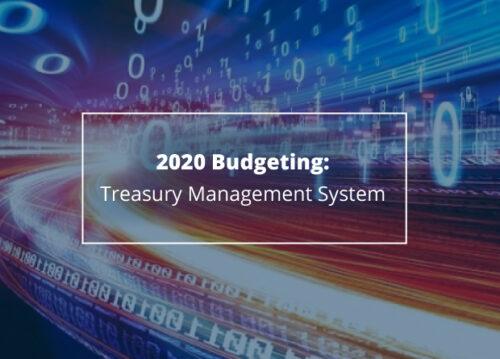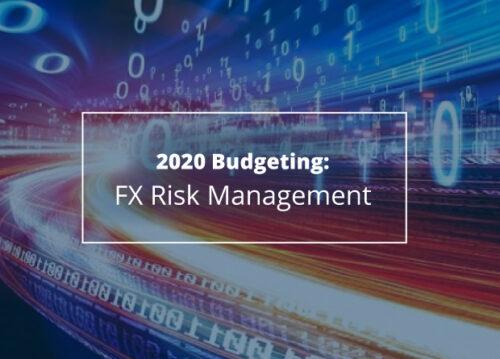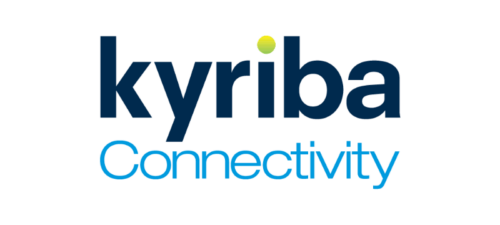Kyriba Blog

Building Resilience Amid Interest Rate Volatility
Interest rate volatility remains top-of-mind for CFOs and finance leaders. As businesses brace for change, vigilance and adaptability become increasingly crucial. The ability to anticipate and respond to interest rate changes can make or break an organization’s financial health. This requires a clear understanding of the many forces at play, using real-time data to make...

-
Filter by tags
-
 Building Resilience Amid Interest Rate VolatilityInterest rate volatility remains top-of-mind for CFOs and finance leaders. As businesses brace for change, vigilance and adaptability become increasingly crucial. The ability to anticipate and respond to interest rate changes can make or break an organization’s financial health. This requires a clear understanding of the many forces at play, using real-time data to make...Read more
Building Resilience Amid Interest Rate VolatilityInterest rate volatility remains top-of-mind for CFOs and finance leaders. As businesses brace for change, vigilance and adaptability become increasingly crucial. The ability to anticipate and respond to interest rate changes can make or break an organization’s financial health. This requires a clear understanding of the many forces at play, using real-time data to make...Read more -
 Optimize Your Cash Forecasting with AIImagine a world where manual processes and guesswork don’t bog down forecasting. Instead, your forecast is created easily using real-time data and predictive analytics. This is the potential of artificial intelligence (AI) in modern financial operations; this is the power of AI in cash forecasting. AI’s ability to process vast amounts of financial data in...Read more
Optimize Your Cash Forecasting with AIImagine a world where manual processes and guesswork don’t bog down forecasting. Instead, your forecast is created easily using real-time data and predictive analytics. This is the potential of artificial intelligence (AI) in modern financial operations; this is the power of AI in cash forecasting. AI’s ability to process vast amounts of financial data in...Read more -
 Key Insights from the Latest Fed Meeting and What They Mean for CFOsThe U.S. Federal Reserve decided to keep interest rates unchanged from 5.25%-5.5% during its June 12, 2024 meeting. This decision, like all decisions from a governing body overseeing monetary policy, has far-reaching implications for corporations and how they manage liquidity performance. How We Got Here For decades, monetary policy had been geared towards growth with...Read more
Key Insights from the Latest Fed Meeting and What They Mean for CFOsThe U.S. Federal Reserve decided to keep interest rates unchanged from 5.25%-5.5% during its June 12, 2024 meeting. This decision, like all decisions from a governing body overseeing monetary policy, has far-reaching implications for corporations and how they manage liquidity performance. How We Got Here For decades, monetary policy had been geared towards growth with...Read more -
 The Tip of the Spear and Why Pride and ERGS Matter More than EverHappy Pride to all of you. Pride Month is a time of celebration. A Celebration of the progress we’ve made, the friendships we’ve established, and the lives we’ve won the right to create, just as others around us have done for centuries. Pride was born in 1969 in a riot at the Stonewall Inn in...Read more
The Tip of the Spear and Why Pride and ERGS Matter More than EverHappy Pride to all of you. Pride Month is a time of celebration. A Celebration of the progress we’ve made, the friendships we’ve established, and the lives we’ve won the right to create, just as others around us have done for centuries. Pride was born in 1969 in a riot at the Stonewall Inn in...Read more -
 Decoding the Impact of ChatGPT for TreasuryGenerative AI, represented by groundbreaking models like ChatGPT, is poised to revolutionize treasury management. However, its integration brings forth a spectrum of implications, from promising opportunities to potential risks. We highlight the potential benefits and risks associated with integrating generative AI in treasury and finance operations. Exploring Generative AI Generative artificial intelligence (AI) is a...Read more
Decoding the Impact of ChatGPT for TreasuryGenerative AI, represented by groundbreaking models like ChatGPT, is poised to revolutionize treasury management. However, its integration brings forth a spectrum of implications, from promising opportunities to potential risks. We highlight the potential benefits and risks associated with integrating generative AI in treasury and finance operations. Exploring Generative AI Generative artificial intelligence (AI) is a...Read more -
 Six Tips to Protect Your Organization Against Payments FraudPayments fraud increased 71 percent from 2022 to 2023, with 96 percent of companies targeted by at least one payments fraud attempt in 2023. Regularly reviewing your infrastructure and verifying your enterprise security measures are robust is crucial, especially to ensure payments fraud protection. One message is clear–if you have strong, consistently executed processes safeguarding...Read more
Six Tips to Protect Your Organization Against Payments FraudPayments fraud increased 71 percent from 2022 to 2023, with 96 percent of companies targeted by at least one payments fraud attempt in 2023. Regularly reviewing your infrastructure and verifying your enterprise security measures are robust is crucial, especially to ensure payments fraud protection. One message is clear–if you have strong, consistently executed processes safeguarding...Read more -
 The Threat of Deepfake Frauds in PaymentImagine this: your CEO’s voice or your CFO’s face—and a request for funds. Something in your gut is telling you that this situation feels ‘off’ but what can you do? It’s the CEO or CFO of the company after all. This is the reality of deepfake fraud, a clever ruse that is not only making...Read more
The Threat of Deepfake Frauds in PaymentImagine this: your CEO’s voice or your CFO’s face—and a request for funds. Something in your gut is telling you that this situation feels ‘off’ but what can you do? It’s the CEO or CFO of the company after all. This is the reality of deepfake fraud, a clever ruse that is not only making...Read more -
 Welcome to Liquidity PerformanceToday marks an exciting new chapter for Kyriba as we unveil our new brand identity. This transformation symbolizes far more than just a visual refresh – it represents our vision and approach to elevating liquidity as a powerful catalyst driving business resilience, agility and growth. At the heart of our brand refresh are three key...Read more
Welcome to Liquidity PerformanceToday marks an exciting new chapter for Kyriba as we unveil our new brand identity. This transformation symbolizes far more than just a visual refresh – it represents our vision and approach to elevating liquidity as a powerful catalyst driving business resilience, agility and growth. At the heart of our brand refresh are three key...Read more -
 Fiat Currency Management Crypto ChallengesFinance leaders have reason to avoid the volatility of alt coins but their lack of visibility into currency exposure could be leaving them vulnerable to a similar risk with some fiat currencies. Bitcoin’s skyrocketing and subsequent free fall in value should be a wakeup call to CFOs, corporate risk managers and others focused on currency...Read more
Fiat Currency Management Crypto ChallengesFinance leaders have reason to avoid the volatility of alt coins but their lack of visibility into currency exposure could be leaving them vulnerable to a similar risk with some fiat currencies. Bitcoin’s skyrocketing and subsequent free fall in value should be a wakeup call to CFOs, corporate risk managers and others focused on currency...Read more -
 10 Things You Need to Know about APIs for TreasuryAPIs continue to be one of the most talked about technologies, as finance leaders look to make their treasury and payments operations more real-time and responsive to market volatility. APIs are critical to the future of bank connectivity, yet they offer significantly more value than connecting treasury systems and ERPs to banks. In a recent...Read more
10 Things You Need to Know about APIs for TreasuryAPIs continue to be one of the most talked about technologies, as finance leaders look to make their treasury and payments operations more real-time and responsive to market volatility. APIs are critical to the future of bank connectivity, yet they offer significantly more value than connecting treasury systems and ERPs to banks. In a recent...Read more -
 Navigating in High-Interest Rate Environment Infographic: A Step-by-Step CFO GuideThe problems associated with spreadsheets are well documented, yet many treasury professionals continue to overlook these shortcomings when it comes to running their overall treasury operations.Read more
Navigating in High-Interest Rate Environment Infographic: A Step-by-Step CFO GuideThe problems associated with spreadsheets are well documented, yet many treasury professionals continue to overlook these shortcomings when it comes to running their overall treasury operations.Read more -
 Three Strategies to Navigate the High-Rate EnvironmentBusinesses face a complex array of challenges in managing liquidity, magnified by the decisions of pivotal global entities. Foremost among these is the direction chartered by the Federal Reserve, which not only sets the course for monetary policy but also cascades its influence across countless corporate decisions. In light of these policy shifts, there is...Read more
Three Strategies to Navigate the High-Rate EnvironmentBusinesses face a complex array of challenges in managing liquidity, magnified by the decisions of pivotal global entities. Foremost among these is the direction chartered by the Federal Reserve, which not only sets the course for monetary policy but also cascades its influence across countless corporate decisions. In light of these policy shifts, there is...Read more -
 How to Cut Costs Without the CutbacksFor the past two years corporations have been in a constant battle to maintain profitable margins while combating rising labor costs, inflation and supply chain disruptions. Labor costs resulting from shortages and the need to retain talent. High inflation resulting from global government spending to sustain economies in times of pandemic distress impacting a rise...Read more
How to Cut Costs Without the CutbacksFor the past two years corporations have been in a constant battle to maintain profitable margins while combating rising labor costs, inflation and supply chain disruptions. Labor costs resulting from shortages and the need to retain talent. High inflation resulting from global government spending to sustain economies in times of pandemic distress impacting a rise...Read more -
 Infographic: How Kyriba Helps Clients with Value RealizationThe problems associated with spreadsheets are well documented, yet many treasury professionals continue to overlook these shortcomings when it comes to running their overall treasury operations.Read more
Infographic: How Kyriba Helps Clients with Value RealizationThe problems associated with spreadsheets are well documented, yet many treasury professionals continue to overlook these shortcomings when it comes to running their overall treasury operations.Read more -
 Kyriba Celebrates National Hispanic Heritage MonthEach year, we honor Hispanic Heritage Month, an annual observance running from September 15 – October 15 to recognize and celebrate the histories, cultures, and traditions of the Hispanic and Latinx communities. While Hispanic Heritage Month began in the United States, Kyribian’s across the globe are honoring their diverse backgrounds and reflecting on how their...Read more
Kyriba Celebrates National Hispanic Heritage MonthEach year, we honor Hispanic Heritage Month, an annual observance running from September 15 – October 15 to recognize and celebrate the histories, cultures, and traditions of the Hispanic and Latinx communities. While Hispanic Heritage Month began in the United States, Kyribian’s across the globe are honoring their diverse backgrounds and reflecting on how their...Read more -
 Kyriba Leading the Charge in Cloud TMS for Both Enterprises and MidmarketIn the wake of escalating global uncertainties, businesses are constantly grappling with unknowns, making liquidity management a top priority. The recent IDC MarketScape Assessment of World-wide Saas and Cloud Treasury Management Software (TMS) Vendors for 2023 provides a compelling testament to the increasing significance of treasury software and the importance of selecting the right technology...Read more
Kyriba Leading the Charge in Cloud TMS for Both Enterprises and MidmarketIn the wake of escalating global uncertainties, businesses are constantly grappling with unknowns, making liquidity management a top priority. The recent IDC MarketScape Assessment of World-wide Saas and Cloud Treasury Management Software (TMS) Vendors for 2023 provides a compelling testament to the increasing significance of treasury software and the importance of selecting the right technology...Read more -
 Tackling Currency Risk in Today’s EconomyIn today’s highly volatile foreign exchange market, companies must be strategic to ensure that their foreign exchange (forex) programs are running as efficiently as possible. With many factors affecting forex exposure, from interest rate movements to political instability, currency volatility and uncertainty show no signs of settling down. During KyribaLive 2023, Andy Gage, SVP of...Read more
Tackling Currency Risk in Today’s EconomyIn today’s highly volatile foreign exchange market, companies must be strategic to ensure that their foreign exchange (forex) programs are running as efficiently as possible. With many factors affecting forex exposure, from interest rate movements to political instability, currency volatility and uncertainty show no signs of settling down. During KyribaLive 2023, Andy Gage, SVP of...Read more -
 How API and ERP Integrations Are Transforming Corporate TreasuryAdopting API technology to integrate ERP systems with treasury systems is a transformative step for corporate treasury management. Such integration facilitates real-time data transfer, ensuring that treasurers are equipped with the most up-to-date financial information for accurate stakeholder reporting and enhanced decision-making. Additionally, APIs bring heightened security in data transfers, offer scalability for growing business...Read more
How API and ERP Integrations Are Transforming Corporate TreasuryAdopting API technology to integrate ERP systems with treasury systems is a transformative step for corporate treasury management. Such integration facilitates real-time data transfer, ensuring that treasurers are equipped with the most up-to-date financial information for accurate stakeholder reporting and enhanced decision-making. Additionally, APIs bring heightened security in data transfers, offer scalability for growing business...Read more -
 Avoid Financial Woes with Cash Management Best PracticesCash management is fundamental to the treasurer’s role, but all too often, inefficiencies and inadequate visibility prevent treasurers from putting their company’s cash to the best use. As an example, a recent PwC Global Treasury Survey still identified cash and liquidity management as the top priority for treasurers. Yet, maximizing returns without increasing risk is...Read more
Avoid Financial Woes with Cash Management Best PracticesCash management is fundamental to the treasurer’s role, but all too often, inefficiencies and inadequate visibility prevent treasurers from putting their company’s cash to the best use. As an example, a recent PwC Global Treasury Survey still identified cash and liquidity management as the top priority for treasurers. Yet, maximizing returns without increasing risk is...Read more -
 Optimizing FX Balance Sheet Hedging with Efficient Frontier ConceptsThe desire for incorporating efficient frontier concepts within FX balance sheet hedging programs has been bubbling up over the past several years. One obvious reason is the ability to execute portfolio hedging decisions that can yield effective risk mitigation results while also minimizing the cost of hedging. However, there have also been hurdles to putting...Read more
Optimizing FX Balance Sheet Hedging with Efficient Frontier ConceptsThe desire for incorporating efficient frontier concepts within FX balance sheet hedging programs has been bubbling up over the past several years. One obvious reason is the ability to execute portfolio hedging decisions that can yield effective risk mitigation results while also minimizing the cost of hedging. However, there have also been hurdles to putting...Read more -
 How to Maximize the Value of Your Kyriba ApplicationUsing a Treasury Management System (TMS) can help organizations monitor cash flows, automate processes, prevent fraud, and make informed liquidity decisions to stay competitive in today’s uncertain economy. Looking to improve their cash visibility and cash forecasting, Bray International chose Kyriba’s TMS solution to tackle their cash management challenges. After a successful TMS implementation, Bray...Read more
How to Maximize the Value of Your Kyriba ApplicationUsing a Treasury Management System (TMS) can help organizations monitor cash flows, automate processes, prevent fraud, and make informed liquidity decisions to stay competitive in today’s uncertain economy. Looking to improve their cash visibility and cash forecasting, Bray International chose Kyriba’s TMS solution to tackle their cash management challenges. After a successful TMS implementation, Bray...Read more -
 Why I Chose KyribaIn today’s rapidly evolving business landscape, selecting the right treasury management system (TMS) is crucial for companies seeking to optimize their financial operations. The TMS selection process involves careful evaluation, where the unique needs and goals of the organization are considered. In this panel session from KyribaLive 2023, moderated by Chris Reynolds, Director of Strategic...Read more
Why I Chose KyribaIn today’s rapidly evolving business landscape, selecting the right treasury management system (TMS) is crucial for companies seeking to optimize their financial operations. The TMS selection process involves careful evaluation, where the unique needs and goals of the organization are considered. In this panel session from KyribaLive 2023, moderated by Chris Reynolds, Director of Strategic...Read more -
 Top Three Cash Flow Mistakes Every Treasury MakesIn today’s rapidly changing financial landscape, effective cash and liquidity management is vital for treasuries to ensure financial stability and support an organization’s strategic objectives. However, many treasurers are falling victim to the same cash flow mistakes over and over again – lack of real-time cash visibility, silos of legacy systems and processes and absence...Read more
Top Three Cash Flow Mistakes Every Treasury MakesIn today’s rapidly changing financial landscape, effective cash and liquidity management is vital for treasuries to ensure financial stability and support an organization’s strategic objectives. However, many treasurers are falling victim to the same cash flow mistakes over and over again – lack of real-time cash visibility, silos of legacy systems and processes and absence...Read more -
 Liquidity Risk Management and Governance for Advancing TreasuryWhen Deloitte asks treasurers the CFO mandate they receive to do their jobs, liquidity risk management is the top response. In fact, about 96% of all the treasurers or treasury organizations polled say that the most critical mandate they receive from their CFO is ensuring the company is safeguarded against liquidity events. The other top...Read more
Liquidity Risk Management and Governance for Advancing TreasuryWhen Deloitte asks treasurers the CFO mandate they receive to do their jobs, liquidity risk management is the top response. In fact, about 96% of all the treasurers or treasury organizations polled say that the most critical mandate they receive from their CFO is ensuring the company is safeguarded against liquidity events. The other top...Read more -
 Taming FX Volatility with Enhanced Currency Risk Management StrategyThe Kyriba Currency Impact Report for Q1 2023 indicated corporate impacts to earnings from FX volatility have continued to decline from the record high losses experienced throughout 2022 with a total reported aggregate headwind of $22.5B – a quarter-over-quarter decrease of 25.5%. For many, this may be a welcome relief. However, the total aggregate headwind...Read more
Taming FX Volatility with Enhanced Currency Risk Management StrategyThe Kyriba Currency Impact Report for Q1 2023 indicated corporate impacts to earnings from FX volatility have continued to decline from the record high losses experienced throughout 2022 with a total reported aggregate headwind of $22.5B – a quarter-over-quarter decrease of 25.5%. For many, this may be a welcome relief. However, the total aggregate headwind...Read more -
 Six Financial Risks Kyriba Can Help CFOs Tackle in 2023As the role of the chief financial officer (CFO) continues to evolve, so do the financial risks they face in today’s dynamic business landscape. In 2023, CFOs are confronted with an array of challenges, ranging from regulatory compliance to cybersecurity threats and economic volatility. This blog focuses on the current financial risks CFOs encounter and...Read more
Six Financial Risks Kyriba Can Help CFOs Tackle in 2023As the role of the chief financial officer (CFO) continues to evolve, so do the financial risks they face in today’s dynamic business landscape. In 2023, CFOs are confronted with an array of challenges, ranging from regulatory compliance to cybersecurity threats and economic volatility. This blog focuses on the current financial risks CFOs encounter and...Read more -
 The Merits of a Platform Utilization StudyWhen Kyriba presented the option of a platform utilization study to the treasury team of Health Care Service Corporation (HCSC), they seized the opportunity. Their treasury team wanted to understand how HCSC was using their treasury management system (TMS), as well as the processes built around it, since the system implementation. A panel discussion at...Read more
The Merits of a Platform Utilization StudyWhen Kyriba presented the option of a platform utilization study to the treasury team of Health Care Service Corporation (HCSC), they seized the opportunity. Their treasury team wanted to understand how HCSC was using their treasury management system (TMS), as well as the processes built around it, since the system implementation. A panel discussion at...Read more -
 Discovering Treasury’s Role in Supply Chain FinanceSupply chain finance (SCF) is a way for companies to better manage their working capital and leverage opportunities made available by high interest rates, recent developments in supply chain management, and strong relationships between buyers, suppliers, banks, and other solution providers. After providing important background information about the opportunities and developments in supply chain finance,...Read more
Discovering Treasury’s Role in Supply Chain FinanceSupply chain finance (SCF) is a way for companies to better manage their working capital and leverage opportunities made available by high interest rates, recent developments in supply chain management, and strong relationships between buyers, suppliers, banks, and other solution providers. After providing important background information about the opportunities and developments in supply chain finance,...Read more -
 Seamless API Integration Helps Treasury Get the Most Out of CashWith cash being more important than ever and increasing pressure to make the most out of their excess reserves, treasury professionals must deploy the necessary tools for quick and easy deployment of excess cash. A panel session at KyribaLive 2023 discussed how Kyriba and global investment portal ICD’s partnership is transforming the way that treasurers...Read more
Seamless API Integration Helps Treasury Get the Most Out of CashWith cash being more important than ever and increasing pressure to make the most out of their excess reserves, treasury professionals must deploy the necessary tools for quick and easy deployment of excess cash. A panel session at KyribaLive 2023 discussed how Kyriba and global investment portal ICD’s partnership is transforming the way that treasurers...Read more -
 Harness the Power of Treasury Analytics“There were 5 exabytes of information created between the dawn of civilization through 2003,” Eric Schmidt, still the CEO at Google in 2010, once proclaimed, “but that much information is now created every 2 days, and the pace is increasing.” Today, data has already become a ‘norm’ for almost all businesses. At KyribaLive 2023, Vincent...Read more
Harness the Power of Treasury Analytics“There were 5 exabytes of information created between the dawn of civilization through 2003,” Eric Schmidt, still the CEO at Google in 2010, once proclaimed, “but that much information is now created every 2 days, and the pace is increasing.” Today, data has already become a ‘norm’ for almost all businesses. At KyribaLive 2023, Vincent...Read more -
 How Streamlined Bank Connectivity Enhances Business Performance for the Office of the CFOIn today’s fast-paced and uncertain business environment, the role of the Chief Financial Officer (CFO) is increasingly complex. A panel session at KyribaLive 2023 discussed how BlackLine and Kyriba, in partnership with RSM, build automated workflows through streamlined bank connectivity for joint clients and support them to enhance business performance. The discussion highlighted the importance...Read more
How Streamlined Bank Connectivity Enhances Business Performance for the Office of the CFOIn today’s fast-paced and uncertain business environment, the role of the Chief Financial Officer (CFO) is increasingly complex. A panel session at KyribaLive 2023 discussed how BlackLine and Kyriba, in partnership with RSM, build automated workflows through streamlined bank connectivity for joint clients and support them to enhance business performance. The discussion highlighted the importance...Read more -
 Improving Working Capital Metrics and Receivables Cash Conversion CycleCorporate insolvencies are expected to grow in 2023 as energy prices, interest rates and direct lending costs increase. The faster companies can improve their cash conversion cycle, the less working capital will be required to support the business, and the higher the certainty of future cash flows. In this KyribaLive 2023 session, Kyriba Working Capital...Read more
Improving Working Capital Metrics and Receivables Cash Conversion CycleCorporate insolvencies are expected to grow in 2023 as energy prices, interest rates and direct lending costs increase. The faster companies can improve their cash conversion cycle, the less working capital will be required to support the business, and the higher the certainty of future cash flows. In this KyribaLive 2023 session, Kyriba Working Capital...Read more -
 Six Questions Every Treasurer Should Ask About How to Forecast Cash FlowConsistent cash flow forecasting is arguably the holy grail of corporate treasury. Treasurers are tasked with a tremendous responsibility to predict the future cash flow performance of their organization. From securing liquidity for internal customers to providing free cash flow guidance and variance analysis to the board of directors, cash forecasting in treasury management is...Read more
Six Questions Every Treasurer Should Ask About How to Forecast Cash FlowConsistent cash flow forecasting is arguably the holy grail of corporate treasury. Treasurers are tasked with a tremendous responsibility to predict the future cash flow performance of their organization. From securing liquidity for internal customers to providing free cash flow guidance and variance analysis to the board of directors, cash forecasting in treasury management is...Read more -
 Elevating the Business Case for a Digital Treasury TransformationThe economic uncertainty and volatility in the market today is causing many organizations to turn to cost-cutting initiatives to ensure business longevity. While most businesses are planning to maintain their budgetary allocations for investment in their people and technology, treasury departments could still face obstacles, including limited budgets and competition with other projects. Therefore, the...Read more
Elevating the Business Case for a Digital Treasury TransformationThe economic uncertainty and volatility in the market today is causing many organizations to turn to cost-cutting initiatives to ensure business longevity. While most businesses are planning to maintain their budgetary allocations for investment in their people and technology, treasury departments could still face obstacles, including limited budgets and competition with other projects. Therefore, the...Read more -
 Warner Bros. Discovery’s Treasury Transformation with KyribaWhen Warner Bros. Discovery completed its merger in 2022, it created an opportunity to review and overhaul the treasury function. The result was a treasury that streamlined and rationalized processes and responsibilities, leveraging Kyriba to drive new levels of efficiency. In this panel session from KyribaLive 2023, Warner Bros. Discovery and system implementation partner Actualize...Read more
Warner Bros. Discovery’s Treasury Transformation with KyribaWhen Warner Bros. Discovery completed its merger in 2022, it created an opportunity to review and overhaul the treasury function. The result was a treasury that streamlined and rationalized processes and responsibilities, leveraging Kyriba to drive new levels of efficiency. In this panel session from KyribaLive 2023, Warner Bros. Discovery and system implementation partner Actualize...Read more -
 Payments Resilience: Top Three Strategies to Eliminate Payments Fraud RisksPayments fraud continues to plague treasury and finance departments, as criminals’ methods are continuously evolving. From new threats like deepfake technology to old standbys like business email compromise (BEC), financial professionals cannot afford to be complacent when it comes to payments fraud risks. Being proactive is imperative when it comes to fraud protection. Organizations need...Read more
Payments Resilience: Top Three Strategies to Eliminate Payments Fraud RisksPayments fraud continues to plague treasury and finance departments, as criminals’ methods are continuously evolving. From new threats like deepfake technology to old standbys like business email compromise (BEC), financial professionals cannot afford to be complacent when it comes to payments fraud risks. Being proactive is imperative when it comes to fraud protection. Organizations need...Read more -
 Making Your Treasury Cash Forecasting ActionableTreasury cash forecasting has become an integral part of an organization’s financial operations, as budgeting and forecasting allow organizations to be more forward thinking. With interest rates on the rise, FX volatility, supply chain challenges and the possibility of a recession looming, this forward-thinking mentality has become increasingly important for organizations. Unfortunately, a 2022 IDC...Read more
Making Your Treasury Cash Forecasting ActionableTreasury cash forecasting has become an integral part of an organization’s financial operations, as budgeting and forecasting allow organizations to be more forward thinking. With interest rates on the rise, FX volatility, supply chain challenges and the possibility of a recession looming, this forward-thinking mentality has become increasingly important for organizations. Unfortunately, a 2022 IDC...Read more -
 Transforming into a Data-Driven TreasuryEach year, AFP Pinnacle Award winner Health Care Service Corporation (HCSC) becomes more data-driven, and a panel session at KyribaLive 2023 reveals how HCSC transformed their treasury operations into a data-centric system, unlocking cash flow, optimizing working capital, and unleashing 1,000+ hours of productivity. In this blog you will find a summary of this inspiring...Read more
Transforming into a Data-Driven TreasuryEach year, AFP Pinnacle Award winner Health Care Service Corporation (HCSC) becomes more data-driven, and a panel session at KyribaLive 2023 reveals how HCSC transformed their treasury operations into a data-centric system, unlocking cash flow, optimizing working capital, and unleashing 1,000+ hours of productivity. In this blog you will find a summary of this inspiring...Read more -
 Unprecedented FX Volatility in 2022 is a Wake-up Call for CFOsThe most recent Kyriba Currency Impact Report confirms the unprecedented wild ride in FX volatility for the calendar year of 2022. Cumulative reported aggregate impact for 2022 was just shy of $170 Billion, by far the largest annual aggregate impact since the Currency Impact Report has been tracking Corporate FX Impacts to financial performance. Regarding...Read more
Unprecedented FX Volatility in 2022 is a Wake-up Call for CFOsThe most recent Kyriba Currency Impact Report confirms the unprecedented wild ride in FX volatility for the calendar year of 2022. Cumulative reported aggregate impact for 2022 was just shy of $170 Billion, by far the largest annual aggregate impact since the Currency Impact Report has been tracking Corporate FX Impacts to financial performance. Regarding...Read more -
 How American Tire Distributors Gains Cash Flow Visibility with Consolidated Cash Reporting & Debt ManagementEfficient financial management and cash flow visibility are critical for an organization’s success. Recently American Tire Distributors (ATD), one of the leading tire distributors in North America, discovered the importance of streamlining treasury operations was necessary to meet leadership’s expectations. At KyribaLive 2023, Ryan Hutchinson, former ATD treasury analyst and Mike Kapala, the finance automation...Read more
How American Tire Distributors Gains Cash Flow Visibility with Consolidated Cash Reporting & Debt ManagementEfficient financial management and cash flow visibility are critical for an organization’s success. Recently American Tire Distributors (ATD), one of the leading tire distributors in North America, discovered the importance of streamlining treasury operations was necessary to meet leadership’s expectations. At KyribaLive 2023, Ryan Hutchinson, former ATD treasury analyst and Mike Kapala, the finance automation...Read more -
 Building a Global Payments Factory – Beam Suntory’s Transformation StoryOperating on a global scale can lead to various challenges for an organization, particularly when it comes to payments processing, payments centralization and payments optimization. This is true for Beam Suntory, the world’s third largest producer of distilled beverages and spirits. A long-time user of Kyriba as a treasury management system, Beam Suntory realized the...Read more
Building a Global Payments Factory – Beam Suntory’s Transformation StoryOperating on a global scale can lead to various challenges for an organization, particularly when it comes to payments processing, payments centralization and payments optimization. This is true for Beam Suntory, the world’s third largest producer of distilled beverages and spirits. A long-time user of Kyriba as a treasury management system, Beam Suntory realized the...Read more -
 Embedded Finance to Embedded Treasury: Are Corporates Ready for the Transition?Embedded finance is the practice of integrating financial services within non-financial platforms and services with the objective of delivering the financial service at the “point of need”. In the not-so-distant past, accessing financial services such as payments, lending, and investments required either a visit to the bank or a redirection to a financial services provider’s...Read more
Embedded Finance to Embedded Treasury: Are Corporates Ready for the Transition?Embedded finance is the practice of integrating financial services within non-financial platforms and services with the objective of delivering the financial service at the “point of need”. In the not-so-distant past, accessing financial services such as payments, lending, and investments required either a visit to the bank or a redirection to a financial services provider’s...Read more -
 Time for CFOs to Uncover Worrisome FX Risk Management IssuesAn insightful report from Deloitte, How to Uncover Hidden FX Risks, highlights the need for CFOs to stay on top of worrisome FX risk management concerns. The report urges CFOs to uncover FX risks that seemingly hide in plain sight, whether they are on a company’s balance sheet or in different intercompany transactions. Although the...Read more
Time for CFOs to Uncover Worrisome FX Risk Management IssuesAn insightful report from Deloitte, How to Uncover Hidden FX Risks, highlights the need for CFOs to stay on top of worrisome FX risk management concerns. The report urges CFOs to uncover FX risks that seemingly hide in plain sight, whether they are on a company’s balance sheet or in different intercompany transactions. Although the...Read more -
 Bank Volatility Reaffirms the Need for Bank ScorecardsBank scorecards have largely fallen by the wayside in recent years. Part of the reason why they are largely forgotten is because of the level of effort involved in manual data collection across multiple banks, as well as continued updating and maintenance. The process can take up to a week’s worth of time to update...Read more
Bank Volatility Reaffirms the Need for Bank ScorecardsBank scorecards have largely fallen by the wayside in recent years. Part of the reason why they are largely forgotten is because of the level of effort involved in manual data collection across multiple banks, as well as continued updating and maintenance. The process can take up to a week’s worth of time to update...Read more -
 How Benchmarking Enables Treasury Project Funding & SuccessBenchmarking can be a critical tool in helping treasury secure a budget, providing the CFO and other key stakeholders with a clearer understanding of current state vs. future state gaps and potential return on investment (ROI) in filling those gaps. This enables stakeholders to make more informed decisions about whether to fund the project. In...Read more
How Benchmarking Enables Treasury Project Funding & SuccessBenchmarking can be a critical tool in helping treasury secure a budget, providing the CFO and other key stakeholders with a clearer understanding of current state vs. future state gaps and potential return on investment (ROI) in filling those gaps. This enables stakeholders to make more informed decisions about whether to fund the project. In...Read more -
 Working Capital Offers an Advantage in Times of VolatilityWhat seems to be an endless news cycle of uncertain economic headwinds has resulted in continuous corporate strategy refinement and the need for real-time insights into working capital impact. This economic pressure has resulted in a laser-eyed focus on strategic working capital management for CFOs. In this blog, part of our Value Engineering Series, we’ll...Read more
Working Capital Offers an Advantage in Times of VolatilityWhat seems to be an endless news cycle of uncertain economic headwinds has resulted in continuous corporate strategy refinement and the need for real-time insights into working capital impact. This economic pressure has resulted in a laser-eyed focus on strategic working capital management for CFOs. In this blog, part of our Value Engineering Series, we’ll...Read more -
 The Four Reasons SVB is a Wake-Up Call to Automate TreasuryCFOs’ worst fears for cash and financing tied directly to Silicon Valley Bank appear to have been alleviated by the U.S. Government’s takeover of the bank. But anyone thinking the crisis is over missed the lesson completely. The learning opportunities for corporate boards and treasury management are abundant and all are pointing to a strong...Read more
The Four Reasons SVB is a Wake-Up Call to Automate TreasuryCFOs’ worst fears for cash and financing tied directly to Silicon Valley Bank appear to have been alleviated by the U.S. Government’s takeover of the bank. But anyone thinking the crisis is over missed the lesson completely. The learning opportunities for corporate boards and treasury management are abundant and all are pointing to a strong...Read more -
 3 Risks to Make Your CFO Approve Your Treasury ProjectYou have completed the necessary legwork and are prepared to propose a treasury management system (TMS) to your CFO. But are you ready to explain the value a TMS will provide your CFO? In this blog, which is part of our Value Engineering series, we will explore why treasury should focus on risk management when...Read more
3 Risks to Make Your CFO Approve Your Treasury ProjectYou have completed the necessary legwork and are prepared to propose a treasury management system (TMS) to your CFO. But are you ready to explain the value a TMS will provide your CFO? In this blog, which is part of our Value Engineering series, we will explore why treasury should focus on risk management when...Read more -
 The Risks of Not Adopting a Treasury Management SystemWhen evaluating the implementation of a treasury management system (TMS), there will always be the inevitable question of why? Each company has processes in place that have worked up until now, so why should we fix today what isn’t broken? Although current processes have worked in the past, there are many risks associated with maintaining...Read more
The Risks of Not Adopting a Treasury Management SystemWhen evaluating the implementation of a treasury management system (TMS), there will always be the inevitable question of why? Each company has processes in place that have worked up until now, so why should we fix today what isn’t broken? Although current processes have worked in the past, there are many risks associated with maintaining...Read more -
 Data: The CFOs Secret Weapon for Cash Forecasting AccuracyCan what’s past be a prologue for cash forecasting? When using statistical modeling and machine learning, yes. CFOs and treasurers have more historical data at their disposal than ever before. If used correctly, forecasts can become more accurate and actionable. Improving Cash Forecasting Accuracy In the past, businesses would use simple historical models to predict...Read more
Data: The CFOs Secret Weapon for Cash Forecasting AccuracyCan what’s past be a prologue for cash forecasting? When using statistical modeling and machine learning, yes. CFOs and treasurers have more historical data at their disposal than ever before. If used correctly, forecasts can become more accurate and actionable. Improving Cash Forecasting Accuracy In the past, businesses would use simple historical models to predict...Read more -
 Receivables Finance Offers Extensive Working Capital ValueLate payments from customers can negatively impact both a company’s cash position, as well as its working capital. If such behavior persists, then the business and its financial health could be in danger. Receivables finance is a useful strategy to mitigate this risk. What Is Receivables Finance? Receivables Finance is a technique that provides organizations...Read more
Receivables Finance Offers Extensive Working Capital ValueLate payments from customers can negatively impact both a company’s cash position, as well as its working capital. If such behavior persists, then the business and its financial health could be in danger. Receivables finance is a useful strategy to mitigate this risk. What Is Receivables Finance? Receivables Finance is a technique that provides organizations...Read more -
 FedNow vs. RTP: Make the Right Decision for B2B PaymentsThis year will mark the emergence of FedNow, the second real-time payment network and the public sector alternative to The Clearing House’s (TCH’s) RTP® network. The Fed and TCH have historically operated public and private sector payment neworks for both low-value batch payments (i.e., FedACH and ACH) and large value payments (i.e., FedWire and CHIPS)...Read more
FedNow vs. RTP: Make the Right Decision for B2B PaymentsThis year will mark the emergence of FedNow, the second real-time payment network and the public sector alternative to The Clearing House’s (TCH’s) RTP® network. The Fed and TCH have historically operated public and private sector payment neworks for both low-value batch payments (i.e., FedACH and ACH) and large value payments (i.e., FedWire and CHIPS)...Read more -
 FX Volatility Builds the Business Case for Treasury SoftwareIn my experience as a treasury practitioner and consultant, I have repeatedly observed the difficulty of getting budget approval for purchasing a treasury management system (TMS). Treasury typically needs to demonstrate to the CFO how adopting a TMS will benefit the entire organization, but competing with other project requests can be quite the shark tank....Read more
FX Volatility Builds the Business Case for Treasury SoftwareIn my experience as a treasury practitioner and consultant, I have repeatedly observed the difficulty of getting budget approval for purchasing a treasury management system (TMS). Treasury typically needs to demonstrate to the CFO how adopting a TMS will benefit the entire organization, but competing with other project requests can be quite the shark tank....Read more -
 Identifying the ROI in a Treasury Transformation ProjectHow do you truly identify the total value of implementing a treasury management system (TMS)? While some aspects of a treasury transformation project may seem black and white, other value components are difficult to quantify, and many are often overlooked completely. When evaluating the ROI of a treasury initiative, it is important to ensure that...Read more
Identifying the ROI in a Treasury Transformation ProjectHow do you truly identify the total value of implementing a treasury management system (TMS)? While some aspects of a treasury transformation project may seem black and white, other value components are difficult to quantify, and many are often overlooked completely. When evaluating the ROI of a treasury initiative, it is important to ensure that...Read more -
 Measuring Recent Trends in Liquidity ManagementIn the early days of the COVID-19 pandemic, companies rushed to increase liquidity. While most industries have returned to near pre-pandemic operations, Kyriba examined how liquidity levels have changed since the onset of the pandemic and the implications for CFOs and treasurers going forward. Reviewing quarterly liquidity levels from December 2018 through December 2021, Kyriba...Read more
Measuring Recent Trends in Liquidity ManagementIn the early days of the COVID-19 pandemic, companies rushed to increase liquidity. While most industries have returned to near pre-pandemic operations, Kyriba examined how liquidity levels have changed since the onset of the pandemic and the implications for CFOs and treasurers going forward. Reviewing quarterly liquidity levels from December 2018 through December 2021, Kyriba...Read more -
 Why Small and Midsize Companies Focus on Foreign CurrencyGrowing internationally should be a challenging yet exciting chapter in every mid-market companies’ story. International business activity results in a wide range of foreign currency (FX) denominated transactional situations, all of which have costs and considerations. In order to keep the headaches, (due to inefficient processes and negative economic impacts) to a minimum, mid-market companies...Read more
Why Small and Midsize Companies Focus on Foreign CurrencyGrowing internationally should be a challenging yet exciting chapter in every mid-market companies’ story. International business activity results in a wide range of foreign currency (FX) denominated transactional situations, all of which have costs and considerations. In order to keep the headaches, (due to inefficient processes and negative economic impacts) to a minimum, mid-market companies...Read more -
 Optimizing Liquidity Management from the Top DownTiming is everything in cash forecasting and liquidity management. Delivering the forecast in a timely manner is critical; the faster it is produced, the faster the organization can act upon it. Furthermore, forecasts hinge on critical moments in a timeline; for example, collecting payments when expected allows for the forecast to be accurate. With a...Read more
Optimizing Liquidity Management from the Top DownTiming is everything in cash forecasting and liquidity management. Delivering the forecast in a timely manner is critical; the faster it is produced, the faster the organization can act upon it. Furthermore, forecasts hinge on critical moments in a timeline; for example, collecting payments when expected allows for the forecast to be accurate. With a...Read more -
 Global Finance Magazine Awards Kyriba: Best Cloud FX SolutionKyriba has recently been recognized for its FX Risk Management solution in Global Finance Magazine’s Gordon W. Platt 2022 and 2023 Foreign Exchange Awards. The company was named as the “Best TMS Provider with FX Module”, “Best Solution for FX Cash-Flow Hedging”, and “Best Cloud Technology FX Solution”. “The maturity and evolution of Kyriba’s FX...Read more
Global Finance Magazine Awards Kyriba: Best Cloud FX SolutionKyriba has recently been recognized for its FX Risk Management solution in Global Finance Magazine’s Gordon W. Platt 2022 and 2023 Foreign Exchange Awards. The company was named as the “Best TMS Provider with FX Module”, “Best Solution for FX Cash-Flow Hedging”, and “Best Cloud Technology FX Solution”. “The maturity and evolution of Kyriba’s FX...Read more -
 CFOs Can Improve Earnings Predictability Despite Currency VolatilityForeign Exchange Risk Volatility Volatility and uncertainty in 2023 have no signs of cooling down as traditional indicators and many financial institutions predict and anticipate a recession to hit this year. Forecasts for the U.S. dollar over the next year are mixed, but it’s safe to say that it will be volatile and unpredictable. While...Read more
CFOs Can Improve Earnings Predictability Despite Currency VolatilityForeign Exchange Risk Volatility Volatility and uncertainty in 2023 have no signs of cooling down as traditional indicators and many financial institutions predict and anticipate a recession to hit this year. Forecasts for the U.S. dollar over the next year are mixed, but it’s safe to say that it will be volatile and unpredictable. While...Read more -
 Liquidity Planning: The CFOs Guiding Compass for 2023While there is much to look forward to in the new year, many critical issues are sure to make cash and liquidity management a massive challenge for CFOs. The end of the “cheap money” era, an inflationary environment, a looming recession, a resurgence of COVID-19, FX volatility and more will produce tough challenges for finance...Read more
Liquidity Planning: The CFOs Guiding Compass for 2023While there is much to look forward to in the new year, many critical issues are sure to make cash and liquidity management a massive challenge for CFOs. The end of the “cheap money” era, an inflationary environment, a looming recession, a resurgence of COVID-19, FX volatility and more will produce tough challenges for finance...Read more -
 Addressing ESG Through Working CapitalThere has been a growing awareness in the corporate community that environmental, social and governance (ESG) investing can no longer be brushed off. But for companies to truly make a meaningful ESG impact, they need to include their supply chain in the process. Implementing better working capital management solutions may prove to be the answer...Read more
Addressing ESG Through Working CapitalThere has been a growing awareness in the corporate community that environmental, social and governance (ESG) investing can no longer be brushed off. But for companies to truly make a meaningful ESG impact, they need to include their supply chain in the process. Implementing better working capital management solutions may prove to be the answer...Read more -
 Building the Business Case for TMS ImplementationConvincing the CFO to approve the adoption of a treasury management system (TMS) almost always requires the treasurer to carefully build a strong business case. During a panel session at a recent Kyriba event, treasurers from multiple companies shared their experiences pitching TMS implementations to their finance chiefs. Establishing a Need for a Treasury Management...Read more
Building the Business Case for TMS ImplementationConvincing the CFO to approve the adoption of a treasury management system (TMS) almost always requires the treasurer to carefully build a strong business case. During a panel session at a recent Kyriba event, treasurers from multiple companies shared their experiences pitching TMS implementations to their finance chiefs. Establishing a Need for a Treasury Management...Read more -
 Liquidity Management is the Lifeblood of Your BusinessAccording to Emmanuel Kant, someone’s intelligence can be measured by the quantity of uncertainties he or she can bear. I think we can also apply this definition of intelligence to organizations and especially to companies. “Liquidity Intelligence” for finance departments is crucial, and during this period of both strategic and operational uncertainty, liquidity is an...Read more
Liquidity Management is the Lifeblood of Your BusinessAccording to Emmanuel Kant, someone’s intelligence can be measured by the quantity of uncertainties he or she can bear. I think we can also apply this definition of intelligence to organizations and especially to companies. “Liquidity Intelligence” for finance departments is crucial, and during this period of both strategic and operational uncertainty, liquidity is an...Read more -
 3 Ways Liquidity Planning Technology Improves Cash Flow Forecasting ResultsThe treasurer and CFO are today more closely linked to strategic financial objectives for the CEO, ensuring finance teams provide informed guidance on navigating risks and opportunities. This year, a revolutionary practice area and innovative technology is transforming the value of short and long-term cash flow forecasting with more certainty and analytics, empowering finance with...Read more
3 Ways Liquidity Planning Technology Improves Cash Flow Forecasting ResultsThe treasurer and CFO are today more closely linked to strategic financial objectives for the CEO, ensuring finance teams provide informed guidance on navigating risks and opportunities. This year, a revolutionary practice area and innovative technology is transforming the value of short and long-term cash flow forecasting with more certainty and analytics, empowering finance with...Read more -
 Top 5 Treasury Practices That Will Change Your 2023For treasury teams, 2022 was full of extremes. With rapid FX fluctuations, price inflation, rising interest rates, new cash forecasting challenges, global recession fears and more, treasurers head into 2023 facing a lot of uncertainty. In speaking with Kyriba clients and reviewing developments from the past year, we have compiled a list of five key...Read more
Top 5 Treasury Practices That Will Change Your 2023For treasury teams, 2022 was full of extremes. With rapid FX fluctuations, price inflation, rising interest rates, new cash forecasting challenges, global recession fears and more, treasurers head into 2023 facing a lot of uncertainty. In speaking with Kyriba clients and reviewing developments from the past year, we have compiled a list of five key...Read more -
 Creating A Culture of Elevated FX Risk AwarenessMany organizations responded quickly to the volatile currency markets over the past six to twelve months, and certainly deserve credit for taking swift action to reduce FX risk. However, what if I were to tell you that the best run treasury functions are even a step above that. Rather than being just responsive to foreign...Read more
Creating A Culture of Elevated FX Risk AwarenessMany organizations responded quickly to the volatile currency markets over the past six to twelve months, and certainly deserve credit for taking swift action to reduce FX risk. However, what if I were to tell you that the best run treasury functions are even a step above that. Rather than being just responsive to foreign...Read more -
 Real-time Payments and Large Value Payment SystemsThe world of payments is interconnected. Innovations don’t happen in isolation, and often depend on what we are deeply familiar with. It’s a mistake to either completely overlook an innovation or consider it to be an end-all, be-all. Real-time payment1 is one such innovation. It has deep interdependence with the traditional Large Value Payment Systems...Read more
Real-time Payments and Large Value Payment SystemsThe world of payments is interconnected. Innovations don’t happen in isolation, and often depend on what we are deeply familiar with. It’s a mistake to either completely overlook an innovation or consider it to be an end-all, be-all. Real-time payment1 is one such innovation. It has deep interdependence with the traditional Large Value Payment Systems...Read more -
 Infographic: Digital Transformation Assessing the Business ImpactKYRIBA VALUE ENGINEERING: A validated, collaborative value assessment for documenting the total value of current state vs. future state. Download the PDFRead more
Infographic: Digital Transformation Assessing the Business ImpactKYRIBA VALUE ENGINEERING: A validated, collaborative value assessment for documenting the total value of current state vs. future state. Download the PDFRead more -
 Five Payments Takeaways from Money 20/20From cryptocurrencies to API banking to payments fraud detection, this year’s Money 20/20 conference in Las Vegas had a major focus on fintech innovations. With over 12,000 attendees and 3,000+ companies, the conference continues to be one of the most prominent events in the payments and banking world. Although this wasn’t my first Money 20/20,...Read more
Five Payments Takeaways from Money 20/20From cryptocurrencies to API banking to payments fraud detection, this year’s Money 20/20 conference in Las Vegas had a major focus on fintech innovations. With over 12,000 attendees and 3,000+ companies, the conference continues to be one of the most prominent events in the payments and banking world. Although this wasn’t my first Money 20/20,...Read more -
 IT Leaders Expect API Use and Adoption to IncreaseAPI usage and adoption has increased and is expected to expand over the next year, according to a new survey by Kyriba and Gartner Peer Insights. The survey results indicate a clear trend of API use cases such as the quick transfer of data and the seamless integration of disparate systems. Expanded API Use Predicted...Read more
IT Leaders Expect API Use and Adoption to IncreaseAPI usage and adoption has increased and is expected to expand over the next year, according to a new survey by Kyriba and Gartner Peer Insights. The survey results indicate a clear trend of API use cases such as the quick transfer of data and the seamless integration of disparate systems. Expanded API Use Predicted...Read more -
 20-Year USD Highs Driving FX Risk Management ChallengesThe Kyriba Currency Impact Report for Q3 2022 illustrates the headaches and challenges that CFOs and Treasurers are contending with related to the strong US Dollar and overall heightened currency volatility. The combination of the USD at a 20-year high and rising interest rates drove the largest reported currency impact in over 10 years and...Read more
20-Year USD Highs Driving FX Risk Management ChallengesThe Kyriba Currency Impact Report for Q3 2022 illustrates the headaches and challenges that CFOs and Treasurers are contending with related to the strong US Dollar and overall heightened currency volatility. The combination of the USD at a 20-year high and rising interest rates drove the largest reported currency impact in over 10 years and...Read more -
 FX Risk: Optimizing Hedging Costs with Protection is CriticalFX risk is on the rise. Volatility has hit major global currencies, rather than only a handful of the usual emerging market suspects. The result has been the largest magnitude of FX-related headwinds we’ve seen in the 10 years we’ve been tracking global FX impact data. Effective FX Exposure Management Figure 1. EUR/USD 6 month...Read more
FX Risk: Optimizing Hedging Costs with Protection is CriticalFX risk is on the rise. Volatility has hit major global currencies, rather than only a handful of the usual emerging market suspects. The result has been the largest magnitude of FX-related headwinds we’ve seen in the 10 years we’ve been tracking global FX impact data. Effective FX Exposure Management Figure 1. EUR/USD 6 month...Read more -
 AI in Liquidity Management: How It Can Assist a Liquidity ManagerArtificial intelligence and machine learning (AI/ML) are emerging treasury technology that have become essential for cash flow forecasting, payments fraud prevention and liquidity management. But is treasury on board and ready for AI in liquidity management? The Difference between ML and AI AI and ML are not technically the same thing. AI is a broad...Read more
AI in Liquidity Management: How It Can Assist a Liquidity ManagerArtificial intelligence and machine learning (AI/ML) are emerging treasury technology that have become essential for cash flow forecasting, payments fraud prevention and liquidity management. But is treasury on board and ready for AI in liquidity management? The Difference between ML and AI AI and ML are not technically the same thing. AI is a broad...Read more -
 Visit Kyriba at AFP 2022! Booth #717Kyriba is providing more options than ever to expand your networking, learning, development, and fun opportunities at Kyriba Events. Learn how technology can help your organization face and prevail over current economic trends, challenges and volatility. Whether you’ve seen Kyriba webinars or presentations in the past, or are entirely new to Kyriba, there are product...Read more
Visit Kyriba at AFP 2022! Booth #717Kyriba is providing more options than ever to expand your networking, learning, development, and fun opportunities at Kyriba Events. Learn how technology can help your organization face and prevail over current economic trends, challenges and volatility. Whether you’ve seen Kyriba webinars or presentations in the past, or are entirely new to Kyriba, there are product...Read more -
 APIs: Enterprise Maturity and Use CasesMost IT leaders take advantage of APIs to support developers and improve business. With plans to continue their integration of APIs, we investigate the state of API adoption across the enterprise as well as examine both internal and external use cases. What impacts do IT leaders expect APIs to have now and in the future?...Read more
APIs: Enterprise Maturity and Use CasesMost IT leaders take advantage of APIs to support developers and improve business. With plans to continue their integration of APIs, we investigate the state of API adoption across the enterprise as well as examine both internal and external use cases. What impacts do IT leaders expect APIs to have now and in the future?...Read more -
 Amid Inflation Concerns, CFOs Prioritize AutomationCFOs are planning to increase IT and technology spending in the next 12 months, according to a new survey of 200 finance leaders by Gartner. While CFOs are planning to reduce budgets overall, they are clearly seeing value in investment in technology. Automation is an area of focus, as finance chiefs view it as a...Read more
Amid Inflation Concerns, CFOs Prioritize AutomationCFOs are planning to increase IT and technology spending in the next 12 months, according to a new survey of 200 finance leaders by Gartner. While CFOs are planning to reduce budgets overall, they are clearly seeing value in investment in technology. Automation is an area of focus, as finance chiefs view it as a...Read more -
 Treasury Steps into the Advisor Role Crisis After CrisisFrom the 2008 global financial crisis to the ongoing COVID-19 pandemic, treasury departments have served as strategic treasury management advisors regarding capital structure, liquidity and finance operations. Without the guidance and leadership of treasury management in these critical moments, many organizations would not have survived. But it begs the question—what can companies do on an...Read more
Treasury Steps into the Advisor Role Crisis After CrisisFrom the 2008 global financial crisis to the ongoing COVID-19 pandemic, treasury departments have served as strategic treasury management advisors regarding capital structure, liquidity and finance operations. Without the guidance and leadership of treasury management in these critical moments, many organizations would not have survived. But it begs the question—what can companies do on an...Read more -
 How Mature is your Treasury Department?Treasury departments aspire to be nimble, data-driven strategic advisors. But this often requires transformation across people, process, and systems. By empowering team members to move away from manual processes and spreadsheets, and embracing leading technology, you can automate repetitive tasks, minimize errors, catch fraud, and make room for value-add, strategic activities. Leveraging a leading treasury...Read more
How Mature is your Treasury Department?Treasury departments aspire to be nimble, data-driven strategic advisors. But this often requires transformation across people, process, and systems. By empowering team members to move away from manual processes and spreadsheets, and embracing leading technology, you can automate repetitive tasks, minimize errors, catch fraud, and make room for value-add, strategic activities. Leveraging a leading treasury...Read more -
 Technology Bridges Skills Gaps for Understaffed Finance TeamsAcquiring and retaining talent is a top priority for many companies in 2022 and beyond. But amidst staffing shortages and new hiring and transition patterns within HR, wide finance skills gaps are highlighted and have many CFOs concerned about the future. In a recent Blackline survey of C-suite executives and financial professionals, a third of...Read more
Technology Bridges Skills Gaps for Understaffed Finance TeamsAcquiring and retaining talent is a top priority for many companies in 2022 and beyond. But amidst staffing shortages and new hiring and transition patterns within HR, wide finance skills gaps are highlighted and have many CFOs concerned about the future. In a recent Blackline survey of C-suite executives and financial professionals, a third of...Read more -
 5 Steps to Automate (and Optimize) Your FX Risk Management ProgramCompanies of all sizes and industries with foreign currency exposures are being impacted by a number of global trade complexities. For many, supply chain disruptions, interest rate, and price index increases are taking a toll on profitability. For many others, the impact from increased foreign currency headwinds is becoming the glaring reality unveiling weaknesses in...Read more
5 Steps to Automate (and Optimize) Your FX Risk Management ProgramCompanies of all sizes and industries with foreign currency exposures are being impacted by a number of global trade complexities. For many, supply chain disruptions, interest rate, and price index increases are taking a toll on profitability. For many others, the impact from increased foreign currency headwinds is becoming the glaring reality unveiling weaknesses in...Read more -
 The Opportunities and Challenges of Real-time B2B PaymentsRecently real-time B2B payments have attracted a lot of attention from corporate clients. As a payments practitioner, I have spent over a decade helping clients adopt innovations that digitize the entire customer journey in which B2B payments management tends to be one of the most important steps. For example, in the B2B e-commerce context, a bad...Read more
The Opportunities and Challenges of Real-time B2B PaymentsRecently real-time B2B payments have attracted a lot of attention from corporate clients. As a payments practitioner, I have spent over a decade helping clients adopt innovations that digitize the entire customer journey in which B2B payments management tends to be one of the most important steps. For example, in the B2B e-commerce context, a bad...Read more -
 Q1 2022 Currency Moves Drive Need for Foundational FX Risk ToolsQ1 2022 CIR Companion Blog The latest Kyriba Currency Impact Report for Q1 2022, which chronicles the impact that currency volatility and currency moves has on reported corporate financial results, illustrates what we have been expecting, the strong dollar run, and currency volatility experienced in the first quarter of 2022 is taking a toll on...Read more
Q1 2022 Currency Moves Drive Need for Foundational FX Risk ToolsQ1 2022 CIR Companion Blog The latest Kyriba Currency Impact Report for Q1 2022, which chronicles the impact that currency volatility and currency moves has on reported corporate financial results, illustrates what we have been expecting, the strong dollar run, and currency volatility experienced in the first quarter of 2022 is taking a toll on...Read more -
 Infographic: IT Priorities and Technology SelectionGartner Peer Insights and Kyriba surveyed 200 IT decision makers who are key stakeholders in purchasing new technology at their organization to understand how they are building their vendor ecosystem, in particular surrounding financial and enterprise resource planning software. Download the PDFRead more
Infographic: IT Priorities and Technology SelectionGartner Peer Insights and Kyriba surveyed 200 IT decision makers who are key stakeholders in purchasing new technology at their organization to understand how they are building their vendor ecosystem, in particular surrounding financial and enterprise resource planning software. Download the PDFRead more -
 Liquidity Performance Infographic: Kyriba Leading the WayKyriba empowers and enables customers to transform the way they access and leverage liquidity to build resilience, generate value, and unlock growth. Download the PDFRead more
Liquidity Performance Infographic: Kyriba Leading the WayKyriba empowers and enables customers to transform the way they access and leverage liquidity to build resilience, generate value, and unlock growth. Download the PDFRead more -
 Why Did Kyriba Build an App Marketplace?Kyriba’s decision to build an app marketplace came from a desire to provide our customers with the latest technology, while fostering innovation in the API space. As organizations’ needs shift and evolve, we want to ensure that all those needs are addressed—whether through our own capabilities or through technology developed by our partners. Creating a...Read more
Why Did Kyriba Build an App Marketplace?Kyriba’s decision to build an app marketplace came from a desire to provide our customers with the latest technology, while fostering innovation in the API space. As organizations’ needs shift and evolve, we want to ensure that all those needs are addressed—whether through our own capabilities or through technology developed by our partners. Creating a...Read more -
 Using Technology to Optimize Bank Relationship ManagementImportance of Bank Relationship Management for the CFO Today’s Bank Relationship Management (BRM) supports effective corporate governance of an organization’s bank accounts as well as driving a more efficient banking strategy. Many modern BRM programs streamline the number of banks, bank accounts and bank fees to support the organization’s growth more effectively. Hamza Benamar, CFO...Read more
Using Technology to Optimize Bank Relationship ManagementImportance of Bank Relationship Management for the CFO Today’s Bank Relationship Management (BRM) supports effective corporate governance of an organization’s bank accounts as well as driving a more efficient banking strategy. Many modern BRM programs streamline the number of banks, bank accounts and bank fees to support the organization’s growth more effectively. Hamza Benamar, CFO...Read more -
 Streamlining Spencer Stuart’s Cash & Payments ManagementTreasury departments at global organizations need cutting-edge technology to ensure that all their payments and cash management needs are handled efficiently. Companies that are still using manual processes will only find their duties more taxing as demands increase. In a KyribaLive 2022 panel session, presented by Elire, Spencer Stuart International (SSI) discussed how implementing Kyriba allowed...Read more
Streamlining Spencer Stuart’s Cash & Payments ManagementTreasury departments at global organizations need cutting-edge technology to ensure that all their payments and cash management needs are handled efficiently. Companies that are still using manual processes will only find their duties more taxing as demands increase. In a KyribaLive 2022 panel session, presented by Elire, Spencer Stuart International (SSI) discussed how implementing Kyriba allowed...Read more -
 FX Risk Management Strategies and Multilateral NettingWith currency volatility on the rise, organizations are looking to improve the efficiency of their FX programs. For companies with operations all over the world, one of the proven corporate risk management strategies for mitigating the impacts of FX volatility is through an intercompany netting program. Wahl Clipper lowered currency risk and significantly reduced costs...Read more
FX Risk Management Strategies and Multilateral NettingWith currency volatility on the rise, organizations are looking to improve the efficiency of their FX programs. For companies with operations all over the world, one of the proven corporate risk management strategies for mitigating the impacts of FX volatility is through an intercompany netting program. Wahl Clipper lowered currency risk and significantly reduced costs...Read more -
 Bank & Enterprise Connectivity Continues to Challenge Finance and ITA recent Pulse Survey reveals the extent of difficulties and challenges bank and enterprise connectivity represents for corporates maintaining and managing their own connectivity. The survey of 100 IT and Engineering leaders covered questions related to how companies today support, partner, deliver and maintain bank connections for ERPs and other systems in general. Banks and...Read more
Bank & Enterprise Connectivity Continues to Challenge Finance and ITA recent Pulse Survey reveals the extent of difficulties and challenges bank and enterprise connectivity represents for corporates maintaining and managing their own connectivity. The survey of 100 IT and Engineering leaders covered questions related to how companies today support, partner, deliver and maintain bank connections for ERPs and other systems in general. Banks and...Read more -
 APIs: More Than Just Bank ConnectivityA recent study by research firm IDC identified that 90% of finance leaders have already implemented or expect to incorporate APIs within their financial technology stack. With global banks continuing to open their platforms to customers and FinTech apps, it is for good reason that CFO’s expectations should be high. And while bank connectivity is...Read more
APIs: More Than Just Bank ConnectivityA recent study by research firm IDC identified that 90% of finance leaders have already implemented or expect to incorporate APIs within their financial technology stack. With global banks continuing to open their platforms to customers and FinTech apps, it is for good reason that CFO’s expectations should be high. And while bank connectivity is...Read more -
 Continued Rise of Corporate Currency Headwinds in 2022The latest Kyriba Currency Impact Report which chronicles the impact that currency volatility and currency moves has on reported corporate financial results documents pretty much what was expected. Net/Net, with dollar strengthening and more volatility, the number of corporates reporting currency headwinds has shot up significantly. Corporate Currency Risk Management: A very challenging market with...Read more
Continued Rise of Corporate Currency Headwinds in 2022The latest Kyriba Currency Impact Report which chronicles the impact that currency volatility and currency moves has on reported corporate financial results documents pretty much what was expected. Net/Net, with dollar strengthening and more volatility, the number of corporates reporting currency headwinds has shot up significantly. Corporate Currency Risk Management: A very challenging market with...Read more -
 Bray International’s Path to Cash VisibilityBray International, one of the world’s leading manufacturers of flow control and automation products, was mired in spreadsheet chaos. With limited visibility into global cash positions, Bray found itself bogged down by inefficient processes. During a session at Kyriba Live 2022, Morty Mandel, VP, director of finance for Bray, discussed how Kyriba helped his company achieve...Read more
Bray International’s Path to Cash VisibilityBray International, one of the world’s leading manufacturers of flow control and automation products, was mired in spreadsheet chaos. With limited visibility into global cash positions, Bray found itself bogged down by inefficient processes. During a session at Kyriba Live 2022, Morty Mandel, VP, director of finance for Bray, discussed how Kyriba helped his company achieve...Read more -
 The Role of APIs in Strategic Cash ForecastingCash forecasting has undergone some substantial changes over the past couple years. While forecasting has always been important, the COVID-19 pandemic highlighted just how critical it is, and why CFOs are prioritizing it more than ever. In a recent webinar, Bob Stark, global head of marketing for Kyriba, and Lisa Husken, value engineer at Kyriba,...Read more
The Role of APIs in Strategic Cash ForecastingCash forecasting has undergone some substantial changes over the past couple years. While forecasting has always been important, the COVID-19 pandemic highlighted just how critical it is, and why CFOs are prioritizing it more than ever. In a recent webinar, Bob Stark, global head of marketing for Kyriba, and Lisa Husken, value engineer at Kyriba,...Read more -
 Accelerating Your Investment Management WorkflowAPIs create more value for finance and treasury through expanded coverage of essential functions and processes beyond connectivity and payments. Cash positioning, liquidity forecasting, trading, and risk management are becoming readily available and are creating more value operationally and strategically. CFOs and Treasurers willing to move away from older, antiquated methods of integration and embrace...Read more
Accelerating Your Investment Management WorkflowAPIs create more value for finance and treasury through expanded coverage of essential functions and processes beyond connectivity and payments. Cash positioning, liquidity forecasting, trading, and risk management are becoming readily available and are creating more value operationally and strategically. CFOs and Treasurers willing to move away from older, antiquated methods of integration and embrace...Read more -
 APIs Drive Enterprise ValueA recent study by research firm IDC identified that 90% of finance leaders have already implemented or expect to incorporate APIs within their financial technology stack. With global banks continuing to open their platforms to customers and FinTech apps, it is for good reason that CFO’s expectations should be high. And while bank connectivity is...Read more
APIs Drive Enterprise ValueA recent study by research firm IDC identified that 90% of finance leaders have already implemented or expect to incorporate APIs within their financial technology stack. With global banks continuing to open their platforms to customers and FinTech apps, it is for good reason that CFO’s expectations should be high. And while bank connectivity is...Read more -
 Effective API Strategies Go Beyond Banks & PaymentsBank Connectivity is Only the Beginning of the Transformation Journey CFOs looking to optimize their processes and systems view APIs as a gateway to enterprise-wide liquidity and the organization’s financial capabilities and health. Finance transformation starts with bank connectivity, leading to real-time decision-making, but the opportunities do not stop there. Bank connectivity and payments help...Read more
Effective API Strategies Go Beyond Banks & PaymentsBank Connectivity is Only the Beginning of the Transformation Journey CFOs looking to optimize their processes and systems view APIs as a gateway to enterprise-wide liquidity and the organization’s financial capabilities and health. Finance transformation starts with bank connectivity, leading to real-time decision-making, but the opportunities do not stop there. Bank connectivity and payments help...Read more -
 Accelerating M&A Day 1 Readiness with API-Integrative SolutionsM&A projects can take advantage of faster connections and more flexibility with open API platforms to speed integrations and be ready for Day 1 with less risk and cost. Across the wide span of finance functions required to start an M&A migration for Day 1 readiness, APIs are the way to speed M&A integration across...Read more
Accelerating M&A Day 1 Readiness with API-Integrative SolutionsM&A projects can take advantage of faster connections and more flexibility with open API platforms to speed integrations and be ready for Day 1 with less risk and cost. Across the wide span of finance functions required to start an M&A migration for Day 1 readiness, APIs are the way to speed M&A integration across...Read more -
 When Is the Right Time to Move from FTP to APIs?Application programming interfaces (APIs) have the potential to revolutionize the treasury and finance function. But when is the time to move from file transfer protocol (FTP) to APIs, and when is FTP still sufficient? Let’s explore the use cases for APIs and when it is appropriate to begin using them. We’ll also look at areas...Read more
When Is the Right Time to Move from FTP to APIs?Application programming interfaces (APIs) have the potential to revolutionize the treasury and finance function. But when is the time to move from file transfer protocol (FTP) to APIs, and when is FTP still sufficient? Let’s explore the use cases for APIs and when it is appropriate to begin using them. We’ll also look at areas...Read more -
 Solving Supply Chain Challenges with Deep-Tier FinancingOver the course of the past year, B2B supply chains have been under very cautious observation. The Suez Canal blockage of May 2021 is a clear indicator of how easily global trade can be severely disrupted; when 12% of global trade passes through the canal and an accident with a single container ship is enough...Read more
Solving Supply Chain Challenges with Deep-Tier FinancingOver the course of the past year, B2B supply chains have been under very cautious observation. The Suez Canal blockage of May 2021 is a clear indicator of how easily global trade can be severely disrupted; when 12% of global trade passes through the canal and an accident with a single container ship is enough...Read more -
 Infographic: APIs -The New Standard for ConnectivityThe problems associated with spreadsheets are well documented, yet many treasury professionals continue to overlook these shortcomings when it comes to running their overall treasury operations.Read more
Infographic: APIs -The New Standard for ConnectivityThe problems associated with spreadsheets are well documented, yet many treasury professionals continue to overlook these shortcomings when it comes to running their overall treasury operations.Read more -
 Why Corporate Working Capital Strategies Have Significantly Changed FocusShifts in Corporate Focus The Kyriba Working Capital team has seen a dramatic increase within the last eighteen months in the number of organizations exploring working capital solutions, or looking to expand on their existing programs and related solutions. When we evaluate payables optimization the main draw for supply chain finance (SCF) programs since the...Read more
Why Corporate Working Capital Strategies Have Significantly Changed FocusShifts in Corporate Focus The Kyriba Working Capital team has seen a dramatic increase within the last eighteen months in the number of organizations exploring working capital solutions, or looking to expand on their existing programs and related solutions. When we evaluate payables optimization the main draw for supply chain finance (SCF) programs since the...Read more -
 Kyriba Ranked as the Leading Treasury Management Systems CompanyKyriba has been ranked as the leading cloud-based finance “Treasury Management Software” and “Best Open Banking Treasury Solution” by Global Finance Magazine. Innovation Across Treasury and Finance Kyriba delivers continuous innovation and value across our products, enabling connectivity, payments, treasury management, risk management, and working capital capabilities. “We are honored that Global Finance has recognized...Read more
Kyriba Ranked as the Leading Treasury Management Systems CompanyKyriba has been ranked as the leading cloud-based finance “Treasury Management Software” and “Best Open Banking Treasury Solution” by Global Finance Magazine. Innovation Across Treasury and Finance Kyriba delivers continuous innovation and value across our products, enabling connectivity, payments, treasury management, risk management, and working capital capabilities. “We are honored that Global Finance has recognized...Read more -
 The Top 5 Trends for CFOs in 2022This past year has offered us many lessons; some bright and full of optimism balanced with other experiences that are best left behind us. Looking forward, there is much to draw from as we look towards a positive 2022. In finance and technology, many trends developed that can be built upon, making for a successful...Read more
The Top 5 Trends for CFOs in 2022This past year has offered us many lessons; some bright and full of optimism balanced with other experiences that are best left behind us. Looking forward, there is much to draw from as we look towards a positive 2022. In finance and technology, many trends developed that can be built upon, making for a successful...Read more -
 2022 Digital Payments TransformationInstant payments, payments fraud, and pandemic-led digital payments transformation projects have changed the B2B payments digital transformation journey for CFOs and CIOs. IT teams recognize that new connectivity methods, such as APIs, are required to integrate their ERP platforms with banks, neobanks, and non-bank payment channels while finance departments are seeing the value of new...Read more
2022 Digital Payments TransformationInstant payments, payments fraud, and pandemic-led digital payments transformation projects have changed the B2B payments digital transformation journey for CFOs and CIOs. IT teams recognize that new connectivity methods, such as APIs, are required to integrate their ERP platforms with banks, neobanks, and non-bank payment channels while finance departments are seeing the value of new...Read more -
 What is a Payments Hub – and Why Do I Need One?According to a recent WEX Worldwide survey commented on by Treasury Today – 52 percent of organizations admit to being victims of payments fraud. Many times treasury is directly affected, because their payments were compromised, while other times, the treasurer is pulled into the conversation to fix whatever vulnerability was exploited for someone else’s payment. Regardless of how or why, treasury is being asked to provide better payments solutions by the CFO, CIO and CISO. Payment hubs provide that answer, in that they offer the global visibility and standardized controls that are so necessary to ensure that every payment is handled in a consistent manner regardless of geography, payment type or who requested it. Payment hubs, which were the subject of a new e-book, ensure payment workflows comply with the organization’s payment policy. Additional reading: 15 Minute Guide to Payment Hubs This is why CIOs are demanding that payment hubs (depicted below) be implemented and are often asking treasury to take charge. What a payments hub should look like – Here’s a graphical representation of a payments hub, including external inputs, key functions, payment types, connectivity and more. When treasury does lead the initiative for a payment hub, they found the following benefits: Standardization The key to eliminating unauthorized payments – even if accidental in nature – is to ensure a standardized set of controls that prevail without exception. Controls could include payment approval scenarios, extra layers of authentication, procedures if approvers are remote and/or unavailable, and specific actions if modifications to the payment are required. The organization’s payment policy should be digitized and enforced by the payment hub software to ensure these controls are consistently applied. Payment Screening Many organizations require payments to be screened against sanctions lists prior to sending those instructions to the bank. While this is a good practice, screening should not stop there. Payment scenarios – e.g. payments being made outside of approved countries, first payment to a new bank account, irregular payment amounts, etc. – should also be screened in real-time so that any suspicious payments can be stopped and quarantined in real-time to be reviewed by authorized reviewers. As payments continue to diversify across multiple channels (e.g. wires, ACH, checks, B2P, blockchain) and become more real-time, organizations cannot rely on treasury staff scanning every payment in real-time; nor can they expect their banks to be the last line of defense. More sophisticated solutions including robotic process automation, should be leveraged to provide the best possible protection. Fortunately, such solutions are available within most payment hubs. Visibility Many treasury teams struggle with having complete transparency into all outgoing payments before they happen. This issue magnifies as organizations also adopt new request for payment strategies to improve collections. Treasury isn’t learning about payment activity early enough to make effective cash and working capital decisions. Payment hubs, through the consolidation of all payment activity, can provide that visibility to treasury so they can be certain about what payments need to be funded. With this added level of precision, working capital can be reduced and a greater percentage of total cash reserves can be deployed to meet organizational KPIs. In many cases, this may directly affect the CFO and Treasurer’s bonus attainment. Cost Not lost in the myriad of benefits is the fact that payment hubs reduce the cost of managing payments. There are several different ways:Read more
What is a Payments Hub – and Why Do I Need One?According to a recent WEX Worldwide survey commented on by Treasury Today – 52 percent of organizations admit to being victims of payments fraud. Many times treasury is directly affected, because their payments were compromised, while other times, the treasurer is pulled into the conversation to fix whatever vulnerability was exploited for someone else’s payment. Regardless of how or why, treasury is being asked to provide better payments solutions by the CFO, CIO and CISO. Payment hubs provide that answer, in that they offer the global visibility and standardized controls that are so necessary to ensure that every payment is handled in a consistent manner regardless of geography, payment type or who requested it. Payment hubs, which were the subject of a new e-book, ensure payment workflows comply with the organization’s payment policy. Additional reading: 15 Minute Guide to Payment Hubs This is why CIOs are demanding that payment hubs (depicted below) be implemented and are often asking treasury to take charge. What a payments hub should look like – Here’s a graphical representation of a payments hub, including external inputs, key functions, payment types, connectivity and more. When treasury does lead the initiative for a payment hub, they found the following benefits: Standardization The key to eliminating unauthorized payments – even if accidental in nature – is to ensure a standardized set of controls that prevail without exception. Controls could include payment approval scenarios, extra layers of authentication, procedures if approvers are remote and/or unavailable, and specific actions if modifications to the payment are required. The organization’s payment policy should be digitized and enforced by the payment hub software to ensure these controls are consistently applied. Payment Screening Many organizations require payments to be screened against sanctions lists prior to sending those instructions to the bank. While this is a good practice, screening should not stop there. Payment scenarios – e.g. payments being made outside of approved countries, first payment to a new bank account, irregular payment amounts, etc. – should also be screened in real-time so that any suspicious payments can be stopped and quarantined in real-time to be reviewed by authorized reviewers. As payments continue to diversify across multiple channels (e.g. wires, ACH, checks, B2P, blockchain) and become more real-time, organizations cannot rely on treasury staff scanning every payment in real-time; nor can they expect their banks to be the last line of defense. More sophisticated solutions including robotic process automation, should be leveraged to provide the best possible protection. Fortunately, such solutions are available within most payment hubs. Visibility Many treasury teams struggle with having complete transparency into all outgoing payments before they happen. This issue magnifies as organizations also adopt new request for payment strategies to improve collections. Treasury isn’t learning about payment activity early enough to make effective cash and working capital decisions. Payment hubs, through the consolidation of all payment activity, can provide that visibility to treasury so they can be certain about what payments need to be funded. With this added level of precision, working capital can be reduced and a greater percentage of total cash reserves can be deployed to meet organizational KPIs. In many cases, this may directly affect the CFO and Treasurer’s bonus attainment. Cost Not lost in the myriad of benefits is the fact that payment hubs reduce the cost of managing payments. There are several different ways:Read more -
 As the Status of LIBOR Changes, Many Finance Teams Worry About UnpreparednessThe London Interbank Offered Rate (LIBOR) is poised to lose its status as the global benchmark interest rate at the beginning of 2022. In a little over a month, the UK Financial Conduct Authority (FCA) will no longer compel banks to submit LIBOR quotes. Thereafter, financial institutions will migrate to risk free rates (RFRs). Unfortunately,...Read more
As the Status of LIBOR Changes, Many Finance Teams Worry About UnpreparednessThe London Interbank Offered Rate (LIBOR) is poised to lose its status as the global benchmark interest rate at the beginning of 2022. In a little over a month, the UK Financial Conduct Authority (FCA) will no longer compel banks to submit LIBOR quotes. Thereafter, financial institutions will migrate to risk free rates (RFRs). Unfortunately,...Read more -
 3 Keys for Treasury Success in AsiaRecently, I had the pleasure of learning more about corporate treasury in Asia during visits to our local offices; meetings with clients in Hong Kong, Malaysia, and Singapore; and by attending several treasury conferences. It should be no surprise that corporate treasury is becoming more sophisticated across Asia as firms continue to demand “best of the best” best practices and scalable, easy to use technology. What I found most interesting about treasury in Asia was: Chinese firms are poised to expand internationally – From a treasury perspective, this interest in growing beyond China has heightened interest in treasury technology that delivers onshore/offshore visibility into cash and currency exposures alongside the need to establish more complex treasury structures such as cash pooling to support onshore/offshore sweeps. Chinese firms are continuing to explore establishing regional treasury centers in Hong Kong or Singapore to align with RMB clearing locations. This is an opportunity where treasury best practices are seen as a significant asset by hiring firms. Automation is not the only goal of treasury technology – Asian-based companies are embracing financial and treasury technology, yet are building ROI models and business justification on variables other than just automation and productivity. With costs of FTEs often much lower than we see in Europe or North America, automation is not the solution to increased workloads. As a result, the driver for technology is implementation of best practices, decision optimization (e.g. improved hedging), and support for treasury transformation. Regional treasury centers are becoming more involved in strategic decision making – Organizations that embrace the opportunity to allow Asian treasury teams to manage key functions (e.g. developing pooling structures or designing hedging programs) are able to deliver more strategic value and drive greater bottom line value than those that try to manage all treasury functions from afar. The knowledge and experience being hired into regional treasury centers, especially in Singapore and Hong Kong, rivals and even exceeds treasury talent in other parts of the world. This expertise is obviously in addition to local knowledge and the ability to work face to face with offshore internal and external partners to treasury. Additional reading: Overcoming Cash Forecastng Challenges: Best Practice Tips for Treasurers Treasury organizations that are already well established in the region already know where the right locations are; how to secure experienced staff; and the importance of adopting world-class treasury technology to ensure global visibility over cash, exposures and financial controls. For organizations considering a greater investment in Asia, it is important to: Choose locations that can offer support in English and local languages, with workable time zones that can also overlap with the head office at some point during the day. Locations that have financial proximity to China (e.g. Hong Kong, Singapore, Macau) are critical so your offshore treasury center is a financial gateway into China itself. Secure experienced staff who not only have global treasury experience, but know how to balance this with local expertise. The right people need to be motivated and trained well, earning new opportunities to leverage their growing treasury knowledge Have the right treasury technology in place that supports global requirements, but also local needs (which could be preferred language, local regulations, specific payment or bank account controls, or dashboards that highlight local treasury KPIs). The reduced footprint offered by the cloud helps, as does the ability for a cloud TMS to enable all treasury offices to support each other to deliver a complete business continuity plan. Asia is an opportunity and those treasury teams that embrace it will be on the road to global treasury success.Read more
3 Keys for Treasury Success in AsiaRecently, I had the pleasure of learning more about corporate treasury in Asia during visits to our local offices; meetings with clients in Hong Kong, Malaysia, and Singapore; and by attending several treasury conferences. It should be no surprise that corporate treasury is becoming more sophisticated across Asia as firms continue to demand “best of the best” best practices and scalable, easy to use technology. What I found most interesting about treasury in Asia was: Chinese firms are poised to expand internationally – From a treasury perspective, this interest in growing beyond China has heightened interest in treasury technology that delivers onshore/offshore visibility into cash and currency exposures alongside the need to establish more complex treasury structures such as cash pooling to support onshore/offshore sweeps. Chinese firms are continuing to explore establishing regional treasury centers in Hong Kong or Singapore to align with RMB clearing locations. This is an opportunity where treasury best practices are seen as a significant asset by hiring firms. Automation is not the only goal of treasury technology – Asian-based companies are embracing financial and treasury technology, yet are building ROI models and business justification on variables other than just automation and productivity. With costs of FTEs often much lower than we see in Europe or North America, automation is not the solution to increased workloads. As a result, the driver for technology is implementation of best practices, decision optimization (e.g. improved hedging), and support for treasury transformation. Regional treasury centers are becoming more involved in strategic decision making – Organizations that embrace the opportunity to allow Asian treasury teams to manage key functions (e.g. developing pooling structures or designing hedging programs) are able to deliver more strategic value and drive greater bottom line value than those that try to manage all treasury functions from afar. The knowledge and experience being hired into regional treasury centers, especially in Singapore and Hong Kong, rivals and even exceeds treasury talent in other parts of the world. This expertise is obviously in addition to local knowledge and the ability to work face to face with offshore internal and external partners to treasury. Additional reading: Overcoming Cash Forecastng Challenges: Best Practice Tips for Treasurers Treasury organizations that are already well established in the region already know where the right locations are; how to secure experienced staff; and the importance of adopting world-class treasury technology to ensure global visibility over cash, exposures and financial controls. For organizations considering a greater investment in Asia, it is important to: Choose locations that can offer support in English and local languages, with workable time zones that can also overlap with the head office at some point during the day. Locations that have financial proximity to China (e.g. Hong Kong, Singapore, Macau) are critical so your offshore treasury center is a financial gateway into China itself. Secure experienced staff who not only have global treasury experience, but know how to balance this with local expertise. The right people need to be motivated and trained well, earning new opportunities to leverage their growing treasury knowledge Have the right treasury technology in place that supports global requirements, but also local needs (which could be preferred language, local regulations, specific payment or bank account controls, or dashboards that highlight local treasury KPIs). The reduced footprint offered by the cloud helps, as does the ability for a cloud TMS to enable all treasury offices to support each other to deliver a complete business continuity plan. Asia is an opportunity and those treasury teams that embrace it will be on the road to global treasury success.Read more -
 Currency Volatility Reaches New Heights of UncertaintyThe Q2 2021 Kyriba Currency Impact Report showed a strong tailwind for many US corporates driven in large part by the strengthening of two main trading currencies for many US corporates, EUR and GBP. Both currencies strengthened steadily through Q2 2021, but currencies have since retreated through Q3 2021, setting up a return of relatively...Read more
Currency Volatility Reaches New Heights of UncertaintyThe Q2 2021 Kyriba Currency Impact Report showed a strong tailwind for many US corporates driven in large part by the strengthening of two main trading currencies for many US corporates, EUR and GBP. Both currencies strengthened steadily through Q2 2021, but currencies have since retreated through Q3 2021, setting up a return of relatively...Read more -
 The Myths of Fraud Detection: Truths of Payment Fraud for Government AgenciesFraud losses are complicated. In addition to potential loss of millions of taxpayer funds, government agencies are also facing negative press, reputational damage, potential impact to credit ratings, and decreased public confidence, making this a silent crisis for Treasurers. At Kyriba we’ve had the opportunity to speak with hundreds of government treasury, finance, and IT...Read more
The Myths of Fraud Detection: Truths of Payment Fraud for Government AgenciesFraud losses are complicated. In addition to potential loss of millions of taxpayer funds, government agencies are also facing negative press, reputational damage, potential impact to credit ratings, and decreased public confidence, making this a silent crisis for Treasurers. At Kyriba we’ve had the opportunity to speak with hundreds of government treasury, finance, and IT...Read more -
 ERP Rationalization: Key Factors for Project SuccessERP migration projects are expensive, complicated and resource intensive, but they run more smoothly when Treasury is involved. Bank connections need to be rebuilt during an ERP migration. So, for Treasury, it’s a good time to determine if ERP rationalization or migrating banking relationships is the better choice for your organization. If using a traditional...Read more
ERP Rationalization: Key Factors for Project SuccessERP migration projects are expensive, complicated and resource intensive, but they run more smoothly when Treasury is involved. Bank connections need to be rebuilt during an ERP migration. So, for Treasury, it’s a good time to determine if ERP rationalization or migrating banking relationships is the better choice for your organization. If using a traditional...Read more -
 Optimizing Working Capital with SCF and Dynamic DiscountingWith supply chain disruptions threatening to torpedo the global economic recovery, companies would be wise to take a closer look at solutions that can help optimize working capital. Historically low interest rates and ongoing trade disputes have done nothing to reduce volatility in the market or offer clarity for buyers and their suppliers about their...Read more
Optimizing Working Capital with SCF and Dynamic DiscountingWith supply chain disruptions threatening to torpedo the global economic recovery, companies would be wise to take a closer look at solutions that can help optimize working capital. Historically low interest rates and ongoing trade disputes have done nothing to reduce volatility in the market or offer clarity for buyers and their suppliers about their...Read more -
 APIs: Greater Payments Connectivity & FunctionalityThe push for superior ERP-to-bank connectivity solutions continues to accelerate as CFOs prepare for the post-pandemic era. Gartner projects that corporate enterprise software spend will top $516 billion this year and $571 billion next year. With application programming interfaces (APIs), CFOs and CIOs can standardize bank and payments connectivity, while opening the door to even...Read more
APIs: Greater Payments Connectivity & FunctionalityThe push for superior ERP-to-bank connectivity solutions continues to accelerate as CFOs prepare for the post-pandemic era. Gartner projects that corporate enterprise software spend will top $516 billion this year and $571 billion next year. With application programming interfaces (APIs), CFOs and CIOs can standardize bank and payments connectivity, while opening the door to even...Read more -
 How to Speed Up Free Cash Flow in a Sluggish EconomyOrganizations large and small are impacted by what has been reported as a sluggish global economy, and for many industries this deceleration in growth has investors concerned about their rate of expansion. The combination of weak to moderate growth and demanding investors raises the immediate need for action by global leaders, and puts supply chain at the forefront of the conversation. When demand for products goes down, and working capital is tied up in inventory, investors know they can expect a lower rate of return. What do companies do to maintain stable growth and mitigate potential investor aggravation or worse their lack of confidence? In this scenario, the supply chain is among the first to be tested, adjusted and possibly disrupted for the better or worse of the company. Savvy finance leaders are looking to manage these seasonal and market driven fluctuations with supply chain finance (SCF) programs, and are seeking the right information to set up and implement SCF to help stabilize their operations. Where there is a question of free cash flow (or the absence of cash), there will be a CFO and treasury group developing a way to optimize working capital. In my last blog, I mentioned one of three pitfalls to a successful supply chain financing initiative is the misalignment of corporate goals and individual incentives. The key challenge here is getting the right people at the table to align goals and teams. Without that cross-departmental commitment and participation, the potential bottom line impact from a supply chain finance program will remain an unrealized opportunity. Additional reading: Making the business case for supply chain finance So, who are the mandatory participants required to successfully launch a supply chain finance program and what is their role? Both the CFO and Treasurer should be the strategic champions of a SCF initiative, as they are mandated to nurture and protect the lifeblood of the organization, its cash position: either by reducing excess cash in exchange of greater yield; or creating free cash flow by extending DPO. It should be obvious that the CEO’s stamp of legitimacy demonstrates the level of priority a SCF initiative has within the organization as a whole. While strategic leadership at the top is a common goal, it’s not one that is easily attainable unless treasury and procurement are working together to build a business case that supports the initiative. The Chief Procurement Officer should play an active part both on internal and external matters. Internally, the CPO should guarantee that the procurement organization’s compensation plan is aligned with the working capital increase objectives and stress the importance of this initiative to his teams. The incentives should be different if the company engages in a Dynamic Discounting exercise or in an extension of DPO. Externally, when possible, the CPO should be involved in the discussions with the most strategic suppliers, and in so doing, set the tone for negotiations through the procurement team. Another department which will be directly impacted by the implementation of a Supply Chain Finance program is the Accounts Payables department. The use of an external platform will have consequences on existing processes - simplifying some, forbidding others and in general forcing a greater rigor on the approval and payment processes as a whole. The AP team will also need to be tactically involved during the functional and testing workshops to ensure the company ERP system and the SCF payment platform are well integrated. As a consequence, it is crucial for the AP Director to be involved early in the process, as the SCF initiative will have a non-negligible impact on its team – namely in terms of time. Finally, as for any technical related activities, the Director needs to be consulted to secure the needed technical resources as well as avoid running into a schedule freeze period, that would result in delaying the whole implementation. It is sometimes difficult to ensure all the above mentioned leaders are actively involved in the SCF initiative. Here are two reasons why the C-level should feel involved in an SCF initiative:Read more
How to Speed Up Free Cash Flow in a Sluggish EconomyOrganizations large and small are impacted by what has been reported as a sluggish global economy, and for many industries this deceleration in growth has investors concerned about their rate of expansion. The combination of weak to moderate growth and demanding investors raises the immediate need for action by global leaders, and puts supply chain at the forefront of the conversation. When demand for products goes down, and working capital is tied up in inventory, investors know they can expect a lower rate of return. What do companies do to maintain stable growth and mitigate potential investor aggravation or worse their lack of confidence? In this scenario, the supply chain is among the first to be tested, adjusted and possibly disrupted for the better or worse of the company. Savvy finance leaders are looking to manage these seasonal and market driven fluctuations with supply chain finance (SCF) programs, and are seeking the right information to set up and implement SCF to help stabilize their operations. Where there is a question of free cash flow (or the absence of cash), there will be a CFO and treasury group developing a way to optimize working capital. In my last blog, I mentioned one of three pitfalls to a successful supply chain financing initiative is the misalignment of corporate goals and individual incentives. The key challenge here is getting the right people at the table to align goals and teams. Without that cross-departmental commitment and participation, the potential bottom line impact from a supply chain finance program will remain an unrealized opportunity. Additional reading: Making the business case for supply chain finance So, who are the mandatory participants required to successfully launch a supply chain finance program and what is their role? Both the CFO and Treasurer should be the strategic champions of a SCF initiative, as they are mandated to nurture and protect the lifeblood of the organization, its cash position: either by reducing excess cash in exchange of greater yield; or creating free cash flow by extending DPO. It should be obvious that the CEO’s stamp of legitimacy demonstrates the level of priority a SCF initiative has within the organization as a whole. While strategic leadership at the top is a common goal, it’s not one that is easily attainable unless treasury and procurement are working together to build a business case that supports the initiative. The Chief Procurement Officer should play an active part both on internal and external matters. Internally, the CPO should guarantee that the procurement organization’s compensation plan is aligned with the working capital increase objectives and stress the importance of this initiative to his teams. The incentives should be different if the company engages in a Dynamic Discounting exercise or in an extension of DPO. Externally, when possible, the CPO should be involved in the discussions with the most strategic suppliers, and in so doing, set the tone for negotiations through the procurement team. Another department which will be directly impacted by the implementation of a Supply Chain Finance program is the Accounts Payables department. The use of an external platform will have consequences on existing processes - simplifying some, forbidding others and in general forcing a greater rigor on the approval and payment processes as a whole. The AP team will also need to be tactically involved during the functional and testing workshops to ensure the company ERP system and the SCF payment platform are well integrated. As a consequence, it is crucial for the AP Director to be involved early in the process, as the SCF initiative will have a non-negligible impact on its team – namely in terms of time. Finally, as for any technical related activities, the Director needs to be consulted to secure the needed technical resources as well as avoid running into a schedule freeze period, that would result in delaying the whole implementation. It is sometimes difficult to ensure all the above mentioned leaders are actively involved in the SCF initiative. Here are two reasons why the C-level should feel involved in an SCF initiative:Read more -
 CEOs: Point-blank News from UK Regulators on Trade Finance ArrangementsAs has been well publicised, on the 9th September all CEOs of trade finance firms received a letter from the UK’s two banking regulators, setting out the Financial Conduct Authority (FCA) and Prudential Regulation Authority (PRA) expectations for firms undertaking trade finance activity. The letter makes reference to several high-profile failures of commodity and trade...Read more
CEOs: Point-blank News from UK Regulators on Trade Finance ArrangementsAs has been well publicised, on the 9th September all CEOs of trade finance firms received a letter from the UK’s two banking regulators, setting out the Financial Conduct Authority (FCA) and Prudential Regulation Authority (PRA) expectations for firms undertaking trade finance activity. The letter makes reference to several high-profile failures of commodity and trade...Read more -
 Migrating to S/4HANA and the Cornerstone for Your Project: Multi-bank ConnectivityIntroduction Frequently in information technology, a term is developed without consideration given to the importance of one of the words that make up the term. This is certainly the case with terminology developed around the effective management of multiple banks and the impact it can have on so many of the IT and finance projects...Read more
Migrating to S/4HANA and the Cornerstone for Your Project: Multi-bank ConnectivityIntroduction Frequently in information technology, a term is developed without consideration given to the importance of one of the words that make up the term. This is certainly the case with terminology developed around the effective management of multiple banks and the impact it can have on so many of the IT and finance projects...Read more -
 Securing High, Risk-Free Returns with Dynamic DiscountingAs treasury's remit becomes increasingly more focused on value creation, the need for organizations to generate higher, risk-free returns is critical. Dynamic discounting could be a key weapon in treasurers' arsenals.Read more
Securing High, Risk-Free Returns with Dynamic DiscountingAs treasury's remit becomes increasingly more focused on value creation, the need for organizations to generate higher, risk-free returns is critical. Dynamic discounting could be a key weapon in treasurers' arsenals.Read more -
 Readying Treasury for Hybrid WorkTo say that the COVID-19 pandemic changed the way treasury departments and companies operate is a massive understatement. Treasury, a function already accustomed to ‘doing more with less,’ began operating remotely—often with a skeleton crew as companies were forced to reduce headcount. Once mass distribution of the COVID-19 vaccine began, companies quickly began to strategize...Read more
Readying Treasury for Hybrid WorkTo say that the COVID-19 pandemic changed the way treasury departments and companies operate is a massive understatement. Treasury, a function already accustomed to ‘doing more with less,’ began operating remotely—often with a skeleton crew as companies were forced to reduce headcount. Once mass distribution of the COVID-19 vaccine began, companies quickly began to strategize...Read more -
 Real-Time Payments and Real-Time FraudAs real-time, instant payments technologies continue to gain momentum, more concerns are being raised about the increased risk of payments fraud. Traditional payment mechanisms settle in the same day or over a period of days after payments are sent from treasury or ERP platforms. However, with real-time payments that clear instantaneously, once the payment is...Read more
Real-Time Payments and Real-Time FraudAs real-time, instant payments technologies continue to gain momentum, more concerns are being raised about the increased risk of payments fraud. Traditional payment mechanisms settle in the same day or over a period of days after payments are sent from treasury or ERP platforms. However, with real-time payments that clear instantaneously, once the payment is...Read more -
 The Pros of Multi-Bank Data Integration SolutionsCompanies used to offer working capital or (supply chain finance) programs to their suppliers primarily in conjunction with a single bank. That was great for the bank, of course, because it allowed the bank to set the terms of the working capital program, to tie the company into a close, long-term relationship, and to gain maximum benefit from lending money to the company’s suppliers while only taking on the credit risk associated with the company itself. The company in question would, of course, usually be a multinational, large or mid-market business with a good credit rating. Banks’ historic involvement with working capital means that even today – when there are numerous bank-agnostic solutions available on the market – many corporates talk to their bank about their working capital requirements first of all and might even end up being sold a solution without properly exploring other options. The risk with this approach is that the bank’s solution may not actually be the best overall solution for the corporate, taking into account factors such as credit availability, fees, funding costs and onboarding requirements, and also whether the organization has any specific needs, such as wanting to provide finance to suppliers in a country where the bank has no presence. Related reading: How to Increase Financial Performance with Working Capital Programs Related reading: How Working Capital Solutions Can Accelerate Free Cash Flow – and Boost Your Capital Investment by 48 Percent Related reading: Busting Payable Finance Myths in the Digital Age Furthermore, when a corporate sets up a working capital program with a single bank, it is effectively giving a large amount of business to the bank, which will certainly put it in that bank’s good books, but could be harmful to its relationships with other banks and increase its exposure to counterparty risk. Since there is a lot of effort involved with setting up a working capital platform initially, it can be difficult for a company to move to another solution if the bank’s service standards slip, it increases interest rates for suppliers at a steep rate, or it allows the technology underpinning the platform to become antiquated. Another consideration is that a bank’s working capital platform will not necessarily integrate with the company’s forecasting and payments solutions, leading to duplication of effort when it comes to reporting and tracking transactions. Meanwhile, the invoices that will be financed under the working capital program will be stored in the company’s enterprise resource planning systems, not its platform, which reduces the efficiency of the payments process. Finally, when onboarding suppliers to its working capital platform, the company will inevitably have to follow the bank’s procedures, which are likely to be more onerous than its own procedures would be. When a company is weighing up whether to use a bank-hosted program or to invest in its own platform, it should take the following selection criteria into account:Read more
The Pros of Multi-Bank Data Integration SolutionsCompanies used to offer working capital or (supply chain finance) programs to their suppliers primarily in conjunction with a single bank. That was great for the bank, of course, because it allowed the bank to set the terms of the working capital program, to tie the company into a close, long-term relationship, and to gain maximum benefit from lending money to the company’s suppliers while only taking on the credit risk associated with the company itself. The company in question would, of course, usually be a multinational, large or mid-market business with a good credit rating. Banks’ historic involvement with working capital means that even today – when there are numerous bank-agnostic solutions available on the market – many corporates talk to their bank about their working capital requirements first of all and might even end up being sold a solution without properly exploring other options. The risk with this approach is that the bank’s solution may not actually be the best overall solution for the corporate, taking into account factors such as credit availability, fees, funding costs and onboarding requirements, and also whether the organization has any specific needs, such as wanting to provide finance to suppliers in a country where the bank has no presence. Related reading: How to Increase Financial Performance with Working Capital Programs Related reading: How Working Capital Solutions Can Accelerate Free Cash Flow – and Boost Your Capital Investment by 48 Percent Related reading: Busting Payable Finance Myths in the Digital Age Furthermore, when a corporate sets up a working capital program with a single bank, it is effectively giving a large amount of business to the bank, which will certainly put it in that bank’s good books, but could be harmful to its relationships with other banks and increase its exposure to counterparty risk. Since there is a lot of effort involved with setting up a working capital platform initially, it can be difficult for a company to move to another solution if the bank’s service standards slip, it increases interest rates for suppliers at a steep rate, or it allows the technology underpinning the platform to become antiquated. Another consideration is that a bank’s working capital platform will not necessarily integrate with the company’s forecasting and payments solutions, leading to duplication of effort when it comes to reporting and tracking transactions. Meanwhile, the invoices that will be financed under the working capital program will be stored in the company’s enterprise resource planning systems, not its platform, which reduces the efficiency of the payments process. Finally, when onboarding suppliers to its working capital platform, the company will inevitably have to follow the bank’s procedures, which are likely to be more onerous than its own procedures would be. When a company is weighing up whether to use a bank-hosted program or to invest in its own platform, it should take the following selection criteria into account:Read more -
 Proactively Counter Fraud and Automate Your Payments ControlsFraud and internal controls violations significantly impact the operational and financial health of organizations of all sizes and scale. CFOs must address these threats while under the constant barrage of ever-increasing and more technologically savvy criminals. Most of the controls at the disposal of CFOs and treasurers are comprised of largely manual and detective processes...Read more
Proactively Counter Fraud and Automate Your Payments ControlsFraud and internal controls violations significantly impact the operational and financial health of organizations of all sizes and scale. CFOs must address these threats while under the constant barrage of ever-increasing and more technologically savvy criminals. Most of the controls at the disposal of CFOs and treasurers are comprised of largely manual and detective processes...Read more -
 Re-examining Your Strategic Treasury Management SystemIf you had the opportunity to reimagine your treasury strategy and overall treasury operation, what would you do? This opportunity was given to our treasury team at Health Care Service Corp (HCSC), a large health insurer operating across the U.S. under the brand names of Blue Cross Blue Shield of Illinois, Texas and more. As...Read more
Re-examining Your Strategic Treasury Management SystemIf you had the opportunity to reimagine your treasury strategy and overall treasury operation, what would you do? This opportunity was given to our treasury team at Health Care Service Corp (HCSC), a large health insurer operating across the U.S. under the brand names of Blue Cross Blue Shield of Illinois, Texas and more. As...Read more -
 FX Predictions, Opportunities and Pitfalls in an Expanding Global MarketThe July 2021 Kyriba Currency Impact Report clearly illustrates that corporate FX risk managers still have a challenging set of market conditions to navigate as the US dollar found footing against other currencies due to aggressive pandemic mitigation efforts and general business activity surging back to life. The combination of a resilient USD and increased...Read more
FX Predictions, Opportunities and Pitfalls in an Expanding Global MarketThe July 2021 Kyriba Currency Impact Report clearly illustrates that corporate FX risk managers still have a challenging set of market conditions to navigate as the US dollar found footing against other currencies due to aggressive pandemic mitigation efforts and general business activity surging back to life. The combination of a resilient USD and increased...Read more -
 Cloudiness in Libor Transition?With less than 6 months to go until the transition from Libor to new overnight risk-free rates, uncertainty lingers as to which rate indices are to be adopted in countries such as the United States. While regulators remain steadfast in their recommendations that risk free rates such as SOFR in the United States and SONIA...Read more
Cloudiness in Libor Transition?With less than 6 months to go until the transition from Libor to new overnight risk-free rates, uncertainty lingers as to which rate indices are to be adopted in countries such as the United States. While regulators remain steadfast in their recommendations that risk free rates such as SOFR in the United States and SONIA...Read more -
 Leveraging Surplus Cash to Minimize Supply Chain RiskOne of the biggest risks to an organization’s supply chain is a vendor’s liquidity issues making it unable to deliver products on time. What practical steps can organizations take to minimize this risk?Read more
Leveraging Surplus Cash to Minimize Supply Chain RiskOne of the biggest risks to an organization’s supply chain is a vendor’s liquidity issues making it unable to deliver products on time. What practical steps can organizations take to minimize this risk?Read more -
 MEMO to IT: Multi-Cloud Environments for Your Banking & PaymentsThe singular, consolidated cloud-based systems architecture for ERPs and the needed connectivity between those systems and partner banks is being redefined. Prior to the evolution and migration of ERPs and early treasury management systems to cloud-based hosted models, the shift from prevailing client-server architecture often led the consolidation of as many modules and processes into...Read more
MEMO to IT: Multi-Cloud Environments for Your Banking & PaymentsThe singular, consolidated cloud-based systems architecture for ERPs and the needed connectivity between those systems and partner banks is being redefined. Prior to the evolution and migration of ERPs and early treasury management systems to cloud-based hosted models, the shift from prevailing client-server architecture often led the consolidation of as many modules and processes into...Read more -
 Leveraging an Effective Working Capital Strategy to Reduce the Cash Conversion CycleThe treasurer’s strategic value to the organization is evolving toward efficiently managing working capital, to meet the growing liquidity needs of their expanding companies.Read more
Leveraging an Effective Working Capital Strategy to Reduce the Cash Conversion CycleThe treasurer’s strategic value to the organization is evolving toward efficiently managing working capital, to meet the growing liquidity needs of their expanding companies.Read more -
 Why CFOs Should Adopt SCF to Meet Cash RequirementsCFOs today depend on the strategic function of treasurers than in previous years. One reason why treasurers’ role has become more aligned to the CFO’s agenda is a direct result of the treasurer’s ability to unlock value within the organization at a low cost, and drive strategic objectives of the CFO, such as offering a more comprehensive view of cash and payments, acquisition strategies and capital allocation strategies. In fact, securing low-cost financing is arguably the corporate treasurer’s primary objective. Among their many responsibilities, ensuring adequate access to liquidity at the appropriate level of risk and cost is imperative for the success of their role. Luckily for treasurers, there is no shortage of banks eager to discuss various funding arrangements, again based on the probable risk and cost of the FI (financial investment). These funding arrangements will most certainly come at a cost to the treasurer, and drawing down to access the needed liquidity will likely be treated as debt on the balance sheet. Consider SCF (supply chain finance) as a dynamic solution to remedy the issue. While not a new strategy, SCF has yet to fully penetrate the corporate market. In a recent survey conducted by Kyriba and Spend Matters, only 10 percent of polled treasury professionals cited an active SCF program at their organization. Therein lies a tremendous opportunity for treasurers and CFOs to gain a strategic market advantage by adopting this proven, liquidity solution. Additional Reading: The Most Important Value That a Truly ‘Strategic’ CFO Can Deliver What is a SCF program? At its core, SCF, or more specifically reverse factoring, is an arrangement where the corporation (buyer) enlists with banks to make payments on their behalf to suppliers. Reverse factoring provides suppliers with early payment of approved invoices, but instead introduces a third party to deliver invoice financing. Reverse factoring offers an attractive alternative to factoring programs for sellers, by offering a lower discount and more flexible terms than they would achieve on their own. For the buyer, reverse factoring offers an opportunity to extend DPO (Days Payable Outstanding), improving working capital while not hurting the liquidity of key suppliers. As an alternative to reverse factoring, dynamic discounting programs are best suited for corporates that have excess cash and liquidity. This type of program is designed for organizations looking for an alternative to low yielding short-term investments as these programs typically yield in excess of 10 percent APR. With dynamic discounting, buyers pay their suppliers early using their own funds. The early payment discount is calculated based on a pre-agreed financing rate and the number of days remaining until payment was originally due. The earlier the payment is made, the greater the discount realized for the buyer. So how does a SCF program help drive a broader capital allocation strategy? SCF programs, especially those housed within treasury technology that also leverage cash management workflows, can greatly improve free cash flow – interest free – via a term extension where reverse factoring is introduced to soften the impact to relevant suppliers. Treasurers are better positioned to satisfy committed share buyback, dividend, acquisition or related milestone payments, or debt buyback targets given the influx of cash flow following reverse factoring program deployment. Thus, as the CFO pushes out DPO, the liquidity position improves at no financial cost and without additional debt on the balance sheet. This brings us to an important point: SCF alone is not the strategy, but rather the strategy of the corporation is to improve liquidity, and SCF is the tool to execute against this strategy. Why SCF programs work It is key to understand that the buyer will have a superior credit rating than their suppliers. A survey conducted by JPMorgan found that 65 percent of corporate suppliers are sub-investment grade. In addition, many suppliers face uncertainty as to when they will be paid from their customers, which puts a tremendous strain on these smaller companies and their ability to manage operations. Given these financial and operational factors, suppliers are eager to obtain low cost, predictable financing, and therefore we have a SCF market.Read more
Why CFOs Should Adopt SCF to Meet Cash RequirementsCFOs today depend on the strategic function of treasurers than in previous years. One reason why treasurers’ role has become more aligned to the CFO’s agenda is a direct result of the treasurer’s ability to unlock value within the organization at a low cost, and drive strategic objectives of the CFO, such as offering a more comprehensive view of cash and payments, acquisition strategies and capital allocation strategies. In fact, securing low-cost financing is arguably the corporate treasurer’s primary objective. Among their many responsibilities, ensuring adequate access to liquidity at the appropriate level of risk and cost is imperative for the success of their role. Luckily for treasurers, there is no shortage of banks eager to discuss various funding arrangements, again based on the probable risk and cost of the FI (financial investment). These funding arrangements will most certainly come at a cost to the treasurer, and drawing down to access the needed liquidity will likely be treated as debt on the balance sheet. Consider SCF (supply chain finance) as a dynamic solution to remedy the issue. While not a new strategy, SCF has yet to fully penetrate the corporate market. In a recent survey conducted by Kyriba and Spend Matters, only 10 percent of polled treasury professionals cited an active SCF program at their organization. Therein lies a tremendous opportunity for treasurers and CFOs to gain a strategic market advantage by adopting this proven, liquidity solution. Additional Reading: The Most Important Value That a Truly ‘Strategic’ CFO Can Deliver What is a SCF program? At its core, SCF, or more specifically reverse factoring, is an arrangement where the corporation (buyer) enlists with banks to make payments on their behalf to suppliers. Reverse factoring provides suppliers with early payment of approved invoices, but instead introduces a third party to deliver invoice financing. Reverse factoring offers an attractive alternative to factoring programs for sellers, by offering a lower discount and more flexible terms than they would achieve on their own. For the buyer, reverse factoring offers an opportunity to extend DPO (Days Payable Outstanding), improving working capital while not hurting the liquidity of key suppliers. As an alternative to reverse factoring, dynamic discounting programs are best suited for corporates that have excess cash and liquidity. This type of program is designed for organizations looking for an alternative to low yielding short-term investments as these programs typically yield in excess of 10 percent APR. With dynamic discounting, buyers pay their suppliers early using their own funds. The early payment discount is calculated based on a pre-agreed financing rate and the number of days remaining until payment was originally due. The earlier the payment is made, the greater the discount realized for the buyer. So how does a SCF program help drive a broader capital allocation strategy? SCF programs, especially those housed within treasury technology that also leverage cash management workflows, can greatly improve free cash flow – interest free – via a term extension where reverse factoring is introduced to soften the impact to relevant suppliers. Treasurers are better positioned to satisfy committed share buyback, dividend, acquisition or related milestone payments, or debt buyback targets given the influx of cash flow following reverse factoring program deployment. Thus, as the CFO pushes out DPO, the liquidity position improves at no financial cost and without additional debt on the balance sheet. This brings us to an important point: SCF alone is not the strategy, but rather the strategy of the corporation is to improve liquidity, and SCF is the tool to execute against this strategy. Why SCF programs work It is key to understand that the buyer will have a superior credit rating than their suppliers. A survey conducted by JPMorgan found that 65 percent of corporate suppliers are sub-investment grade. In addition, many suppliers face uncertainty as to when they will be paid from their customers, which puts a tremendous strain on these smaller companies and their ability to manage operations. Given these financial and operational factors, suppliers are eager to obtain low cost, predictable financing, and therefore we have a SCF market.Read more -
 CFOs and the Importance of Relationship BankingCFOs are the custodians of financial growth for enterprise business. A key part of that role is to build and foster mutually beneficial relationships with banks and funding partners, otherwise known as relationship banking. But what is relationship banking and how does it work? Since banking relationships are built upon the provision of services; whether...Read more
CFOs and the Importance of Relationship BankingCFOs are the custodians of financial growth for enterprise business. A key part of that role is to build and foster mutually beneficial relationships with banks and funding partners, otherwise known as relationship banking. But what is relationship banking and how does it work? Since banking relationships are built upon the provision of services; whether...Read more -
 Accelerating ERP SAP Certification Projects with Certified IntegrationsERP SAP Certification of Kyriba Payments Network Now, more than ever, organizations using SAP have additional reason for confidence in reaping benefits and value from Kyriba in tandem with their SAP ECC or S/4HANA ERP platforms. As a newly certified SAP partner, Kyriba continues to expand the value delivered to SAP customers through accelerating ERP,...Read more
Accelerating ERP SAP Certification Projects with Certified IntegrationsERP SAP Certification of Kyriba Payments Network Now, more than ever, organizations using SAP have additional reason for confidence in reaping benefits and value from Kyriba in tandem with their SAP ECC or S/4HANA ERP platforms. As a newly certified SAP partner, Kyriba continues to expand the value delivered to SAP customers through accelerating ERP,...Read more -
 Currency Volatility is Down: How Smart FX Teams are Preparing for the Next WaveThe Kyriba Currency Impact Report reveals largely what was anticipated by risk managers and treasury leaders, as overall currency volatility returned to pre-pandemic levels and the US Dollar weakened against most major market currencies during the last quarter of 2020. The US currency weakened in Q4 due to a variety of factors, but the most...Read more
Currency Volatility is Down: How Smart FX Teams are Preparing for the Next WaveThe Kyriba Currency Impact Report reveals largely what was anticipated by risk managers and treasury leaders, as overall currency volatility returned to pre-pandemic levels and the US Dollar weakened against most major market currencies during the last quarter of 2020. The US currency weakened in Q4 due to a variety of factors, but the most...Read more -
 Greensill’s SCF Clouds Can Have a Silver LiningWarren Buffett once said “Risk comes from not knowing what you are doing,” but he might just as well have added: “or not knowing who you are doing it with.” Recent events in Supply Chain Finance (SCF) have brought the importance of that observation into sharp focus, as the demise of one of the leading...Read more
Greensill’s SCF Clouds Can Have a Silver LiningWarren Buffett once said “Risk comes from not knowing what you are doing,” but he might just as well have added: “or not knowing who you are doing it with.” Recent events in Supply Chain Finance (SCF) have brought the importance of that observation into sharp focus, as the demise of one of the leading...Read more -
 LIBOR Transition — the Train has Left the Station. Are you Onboard?What is happening? For over 40 years financial institutions have used LIBOR and Other Interbank Offering Rates (IBOR) as a reference rate for pricing approximately $400 Trillion in loans and derivative instruments. With the 2008 financial crisis, bank credit worthiness began being priced into the interbank lending market. This, coupled with a susceptibility to manipulation...Read more
LIBOR Transition — the Train has Left the Station. Are you Onboard?What is happening? For over 40 years financial institutions have used LIBOR and Other Interbank Offering Rates (IBOR) as a reference rate for pricing approximately $400 Trillion in loans and derivative instruments. With the 2008 financial crisis, bank credit worthiness began being priced into the interbank lending market. This, coupled with a susceptibility to manipulation...Read more -
 Virtual Event Recap: Kyriba Global SummitWe’re still enjoying the buzz and activity from the Kyriba Global Summit. While we focused on optimizing the viewer experience by keeping all sessions short and enabling customizable three-hour agendas, we actually produced 62 sessions in 5 languages, reflecting the insights from executives at 25 corporations, all delivered to an audience of nearly 4,000 registered...Read more
Virtual Event Recap: Kyriba Global SummitWe’re still enjoying the buzz and activity from the Kyriba Global Summit. While we focused on optimizing the viewer experience by keeping all sessions short and enabling customizable three-hour agendas, we actually produced 62 sessions in 5 languages, reflecting the insights from executives at 25 corporations, all delivered to an audience of nearly 4,000 registered...Read more -
 A Preview of
A Preview of
Kyriba Global SummitFollowing on from my blog on why I joined Kyriba, I am proud to preview the Kyriba Global Summit, a three-and-a-half-hour virtual event in multiple languages that takes place on November 10, 11 and 17. The Kyriba Global Summit features stories from forward-thinking finance, treasury, and IT executives, who’ve found innovative new ways to drive...Read more -
 Infographic: 6 Key Reasons Why Kyriba Connectivity Network is a Better Solution for ERP Bank ConnectivityThe problems associated with spreadsheets are well documented, yet many treasury professionals continue to overlook these shortcomings when it comes to running their overall treasury operations.Read more
Infographic: 6 Key Reasons Why Kyriba Connectivity Network is a Better Solution for ERP Bank ConnectivityThe problems associated with spreadsheets are well documented, yet many treasury professionals continue to overlook these shortcomings when it comes to running their overall treasury operations.Read more -
 3 Essential Criteria for Getting Executive Approval on Finance Transformation ProjectsThe economic downturn brought on by COVID-19 has transformed the way CFOs and CIOs are prioritizing operational expenses. While a strong 2019 put multinational corporations in a position to invest in new finance transformation projects to accelerate growth, recent market and business performance have finance teams reevaluating their current and future investments. Board rooms buzzing...Read more
3 Essential Criteria for Getting Executive Approval on Finance Transformation ProjectsThe economic downturn brought on by COVID-19 has transformed the way CFOs and CIOs are prioritizing operational expenses. While a strong 2019 put multinational corporations in a position to invest in new finance transformation projects to accelerate growth, recent market and business performance have finance teams reevaluating their current and future investments. Board rooms buzzing...Read more -
 SAP S/4HANA: How to Make a Successful TransformationSAP S/4HANA is SAP’s next-generation enterprise resource planning (ERP) system for large businesses. Many organizations that are currently using the SAP business suite are looking to upgrade to the new solution, often as part of a wider digital transformation. As a digital core, S/4HANA is the link between the key business functions within an organization,...Read more
SAP S/4HANA: How to Make a Successful TransformationSAP S/4HANA is SAP’s next-generation enterprise resource planning (ERP) system for large businesses. Many organizations that are currently using the SAP business suite are looking to upgrade to the new solution, often as part of a wider digital transformation. As a digital core, S/4HANA is the link between the key business functions within an organization,...Read more -
 COVID-19, Currencies and Clarity: A $12B Challenge for CFOsIs it time for investors to demand more clarity from corporate finance chiefs? The July 2020 Currency Impact Report from Kyriba reveals a startling spike in foreign exchange (FX) impacts, with quantified negative currency impacts above $12 billion for North American and European multinational corporations in Q1 2020. Despite the beginning of an economic slowdown,...Read more
COVID-19, Currencies and Clarity: A $12B Challenge for CFOsIs it time for investors to demand more clarity from corporate finance chiefs? The July 2020 Currency Impact Report from Kyriba reveals a startling spike in foreign exchange (FX) impacts, with quantified negative currency impacts above $12 billion for North American and European multinational corporations in Q1 2020. Despite the beginning of an economic slowdown,...Read more -
 IT’s Most Common ERP Bank Connectivity ChallengesBank connectivity is a major issue for companies and often turns out to be far more challenging than IT departments realize when they engage in a bank connectivity project. This blog lists a few common challenges IT leaders face and how they can be tackled with the use of Connectivity-as-a-Service. Challenge #1: Homemade Bank Connectivity...Read more
IT’s Most Common ERP Bank Connectivity ChallengesBank connectivity is a major issue for companies and often turns out to be far more challenging than IT departments realize when they engage in a bank connectivity project. This blog lists a few common challenges IT leaders face and how they can be tackled with the use of Connectivity-as-a-Service. Challenge #1: Homemade Bank Connectivity...Read more -
 How Bank Connectivity Can Throw a Wrench in Your ERP MigrationBank integrations are one of the riskiest components of ERP migration projects. Connecting treasury and payment systems to banks is a daunting task for organizations, especially when internal IT resources are stretched thin at the start of a cloud ERP integration project. ERP bank integration complexity emerges as a critical challenge for organizations working to...Read more
How Bank Connectivity Can Throw a Wrench in Your ERP MigrationBank integrations are one of the riskiest components of ERP migration projects. Connecting treasury and payment systems to banks is a daunting task for organizations, especially when internal IT resources are stretched thin at the start of a cloud ERP integration project. ERP bank integration complexity emerges as a critical challenge for organizations working to...Read more -
 Driving Payments Security and Efficiency During COVID-19: Best practices for Finance and Treasury TeamsCybercriminals and fraudsters are taking advantage of the COVID-19 pandemic to attempt increasingly sophisticated phishing attacks, payment frauds and scams. In late March, IT security company Barracuda Networks reported a 667 percent increase in phishing emails in less than a month. Sadly, cybercriminals and fraudsters are preying on the general environment of fear and uncertainty...Read more
Driving Payments Security and Efficiency During COVID-19: Best practices for Finance and Treasury TeamsCybercriminals and fraudsters are taking advantage of the COVID-19 pandemic to attempt increasingly sophisticated phishing attacks, payment frauds and scams. In late March, IT security company Barracuda Networks reported a 667 percent increase in phishing emails in less than a month. Sadly, cybercriminals and fraudsters are preying on the general environment of fear and uncertainty...Read more -
 COVID-19: Adjusting to Currency VolatilityThe COVID-19 pandemic has brought numerous challenges for companies around the world – and for many organizations, the impact on currency volatility is among the most significant. As leading currency market experts explained during a recent Kyriba webinar, large companies will be looking closely at their portfolio of exposures in this market. Given the current...Read more
COVID-19: Adjusting to Currency VolatilityThe COVID-19 pandemic has brought numerous challenges for companies around the world – and for many organizations, the impact on currency volatility is among the most significant. As leading currency market experts explained during a recent Kyriba webinar, large companies will be looking closely at their portfolio of exposures in this market. Given the current...Read more -
 COVID-19: A Wake-up Call to Better Manage Working Capital and De-risk Supply ChainsMuch has already been said and written about COVID-19 and its impact on the world. Despite multiple life-stimulating attempts by Feds and governments worldwide, the world is on the verge of falling into a deep recession. Stock markets are barely recovering from the worst crash since the infamous “Black Monday” of 1987. The global pandemic...Read more
COVID-19: A Wake-up Call to Better Manage Working Capital and De-risk Supply ChainsMuch has already been said and written about COVID-19 and its impact on the world. Despite multiple life-stimulating attempts by Feds and governments worldwide, the world is on the verge of falling into a deep recession. Stock markets are barely recovering from the worst crash since the infamous “Black Monday” of 1987. The global pandemic...Read more -
 COVID-19 Crisis Fuels Treasury Digital TransformationWhat we have learned in the past few months since the pandemic began is that some CFOs – and their companies – were unprepared to weather the resulting economic shock brought on by COVID-19. And, in most cases, it left treasury and finance professionals scrambling to support or manage needed analysis on liquidity, financial risk...Read more
COVID-19 Crisis Fuels Treasury Digital TransformationWhat we have learned in the past few months since the pandemic began is that some CFOs – and their companies – were unprepared to weather the resulting economic shock brought on by COVID-19. And, in most cases, it left treasury and finance professionals scrambling to support or manage needed analysis on liquidity, financial risk...Read more -
 Enterprise Liquidity Management: The Prescription for Treasury’s Revival in a PandemicThe magnitude and reach of the COVID-19 pandemic is unprecedented, with everything coming to a grinding halt. Heightened uncertainty has become the norm and one could argue that the scope of the disruption is greater than anything we have experienced before. No one can escape the reality of the situation — with COVID-19, everyone is...Read more
Enterprise Liquidity Management: The Prescription for Treasury’s Revival in a PandemicThe magnitude and reach of the COVID-19 pandemic is unprecedented, with everything coming to a grinding halt. Heightened uncertainty has become the norm and one could argue that the scope of the disruption is greater than anything we have experienced before. No one can escape the reality of the situation — with COVID-19, everyone is...Read more -
 A Treasurer Reflects on Surviving a CrisisHuddle up treasurers, you are once again the CFO’s most valuable asset. In times of volatility and crisis, your role becomes even more critical and valuable to the organization, but this isn’t the first time we’ve experienced something like this. Through 9/11, the 2003 Northeast blackout and the 2008 financial crisis you were able to...Read more
A Treasurer Reflects on Surviving a CrisisHuddle up treasurers, you are once again the CFO’s most valuable asset. In times of volatility and crisis, your role becomes even more critical and valuable to the organization, but this isn’t the first time we’ve experienced something like this. Through 9/11, the 2003 Northeast blackout and the 2008 financial crisis you were able to...Read more -
 Managing Risk in CrisisA lot has changed in the days since we published the “Treasury’s Opportunity During a Crisis” blog on Thursday, March 11th. I received a lot of positive and insightful feedback from the last blog, where we talked about how treasury teams can perfect business continuity plans, review how effectively they are actively managing their liquidity...Read more
Managing Risk in CrisisA lot has changed in the days since we published the “Treasury’s Opportunity During a Crisis” blog on Thursday, March 11th. I received a lot of positive and insightful feedback from the last blog, where we talked about how treasury teams can perfect business continuity plans, review how effectively they are actively managing their liquidity...Read more -
 Treasury’s Opportunity During a CrisisThe COVID-19 pandemic has already caused panic in financial markets, with anyone’s guess how much more damage is yet to come. In the face of crisis, corporate treasury teams are still expected to calm the storm within an organization, especially in an environment that features as much concern, panic and uncertainty as we are seeing...Read more
Treasury’s Opportunity During a CrisisThe COVID-19 pandemic has already caused panic in financial markets, with anyone’s guess how much more damage is yet to come. In the face of crisis, corporate treasury teams are still expected to calm the storm within an organization, especially in an environment that features as much concern, panic and uncertainty as we are seeing...Read more -
 Treasury Best Practices for Business ContinuityKyriba recently held a webinar attended by more than 500 treasury professionals that focused on the critical importance of business continuity planning (BCP) for treasury. One quarter of the audience admitted to not having such a plan in place, while nearly 30 percent said they had a plan in place, but had never tested it, according to webinar polling. Needless to say, audience members were eagerly looking for best practices to make their continuity planning more complete. We also learned from the audience that treasury typically manages their own planning and those plans haven’t changed much despite the movement to the cloud. The cloud offers a very different way of thinking about BCP. The best feature of the cloud is that it takes the entire software solution (and data) off your premises. Data centers used by a cloud treasury provider such as Kyriba reside in different global locations than the company offices, so your treasury system still operates without interruption even if the company offices are disabled or inaccessible. Further, cloud treasury providers maintain their own business continuity plans to ensure the treasury software-as-a-service is always running. They build in redundancy of operations, replicating the entire environment so that all the data, the user interfaces, the bank connections, and the security protocols are all available in the “backup location.” If done well, a treasury team should not be able to tell if they are in the primary environment or in the backup. It is especially important that the security is identical in business continuity mode because if that were not the case, then fraudsters would simply focus their hacking efforts on putting platforms into a backup state where systems could be more easily exploited. The other characteristic of cloud-based treasury systems is that those systems are globally accessible via the cloud. Because of this, the same workflows can be run anywhere in the world by authorized users. If set up correctly, the treasury system will feature standardized templates, processes, and visual workflow maps so that temporary and new employees can be on boarded quickly. This ensures that treasury is run the same way no matter who is performing the tasks. This is especially important for business continuity because part of an effective BCP program is ensuring smooth operations even when treasury personnel in the main office are not available. Whether their location loses power or internet access – or the treasury team’s number came up in Powerball lottery – the reality is that the need for treasury exists whether that team is available or not. The right treasury technology deployment will have standardized workflows that can be managed by anyone that is authorized from anywhere the company operates. And it will be do so because of the cloud accessibility combined with the treasury system being a single repository for all data, documentation and visual workflows. Not All Clouds are Built the Same Treasury systems need to be mobile. This is more than just being available in the cloud, however. Treasury systems need to work whether the user is at home (possibly on a really old desktop with an old internet browser), via a tablet or smartphone, and with low speed web connections (e.g. having to use your iPhone as a hotspot for your laptop to get online). If a treasury system cannot support multiple scenarios, it isn’t going to be a reliable component in your treasury’s business continuity plans. And, unfortunately, there are still treasury systems that are not device independent. Make sure that your business requirements also include testing just how mobile your treasury system actually is. Security is Really, Really Important While we briefly discussed the importance of a vendor maintaining security protocols in both production and BCP mode, the treasury team must have the same consistency in their application security. Presuming treasury’s choice of technology aligned with the organization’s information security policies, there will be certain authentication protocols used to log into the treasury system. They may include multi-factor authentication using hard or soft tokens, IP Filtering, virtual keyboards, and/or single sign on (SSO).Read more
Treasury Best Practices for Business ContinuityKyriba recently held a webinar attended by more than 500 treasury professionals that focused on the critical importance of business continuity planning (BCP) for treasury. One quarter of the audience admitted to not having such a plan in place, while nearly 30 percent said they had a plan in place, but had never tested it, according to webinar polling. Needless to say, audience members were eagerly looking for best practices to make their continuity planning more complete. We also learned from the audience that treasury typically manages their own planning and those plans haven’t changed much despite the movement to the cloud. The cloud offers a very different way of thinking about BCP. The best feature of the cloud is that it takes the entire software solution (and data) off your premises. Data centers used by a cloud treasury provider such as Kyriba reside in different global locations than the company offices, so your treasury system still operates without interruption even if the company offices are disabled or inaccessible. Further, cloud treasury providers maintain their own business continuity plans to ensure the treasury software-as-a-service is always running. They build in redundancy of operations, replicating the entire environment so that all the data, the user interfaces, the bank connections, and the security protocols are all available in the “backup location.” If done well, a treasury team should not be able to tell if they are in the primary environment or in the backup. It is especially important that the security is identical in business continuity mode because if that were not the case, then fraudsters would simply focus their hacking efforts on putting platforms into a backup state where systems could be more easily exploited. The other characteristic of cloud-based treasury systems is that those systems are globally accessible via the cloud. Because of this, the same workflows can be run anywhere in the world by authorized users. If set up correctly, the treasury system will feature standardized templates, processes, and visual workflow maps so that temporary and new employees can be on boarded quickly. This ensures that treasury is run the same way no matter who is performing the tasks. This is especially important for business continuity because part of an effective BCP program is ensuring smooth operations even when treasury personnel in the main office are not available. Whether their location loses power or internet access – or the treasury team’s number came up in Powerball lottery – the reality is that the need for treasury exists whether that team is available or not. The right treasury technology deployment will have standardized workflows that can be managed by anyone that is authorized from anywhere the company operates. And it will be do so because of the cloud accessibility combined with the treasury system being a single repository for all data, documentation and visual workflows. Not All Clouds are Built the Same Treasury systems need to be mobile. This is more than just being available in the cloud, however. Treasury systems need to work whether the user is at home (possibly on a really old desktop with an old internet browser), via a tablet or smartphone, and with low speed web connections (e.g. having to use your iPhone as a hotspot for your laptop to get online). If a treasury system cannot support multiple scenarios, it isn’t going to be a reliable component in your treasury’s business continuity plans. And, unfortunately, there are still treasury systems that are not device independent. Make sure that your business requirements also include testing just how mobile your treasury system actually is. Security is Really, Really Important While we briefly discussed the importance of a vendor maintaining security protocols in both production and BCP mode, the treasury team must have the same consistency in their application security. Presuming treasury’s choice of technology aligned with the organization’s information security policies, there will be certain authentication protocols used to log into the treasury system. They may include multi-factor authentication using hard or soft tokens, IP Filtering, virtual keyboards, and/or single sign on (SSO).Read more -
 The Evolution of FX and the Role of e-CurrenciesThe last 50 years have brought several major changes to the world’s currency landscape. In 1971, the Bretton Woods System was terminated, meaning that the value of the U.S. dollar was no longer pegged to gold. Other milestones included the merging of the Deutschmark and the East German mark following the 1989 collapse of the...Read more
The Evolution of FX and the Role of e-CurrenciesThe last 50 years have brought several major changes to the world’s currency landscape. In 1971, the Bretton Woods System was terminated, meaning that the value of the U.S. dollar was no longer pegged to gold. Other milestones included the merging of the Deutschmark and the East German mark following the 1989 collapse of the...Read more -
 Lessons Learned to Unlock Free Cash FlowDespite challenges in the local business environment, companies’ cash to cash cycle (C2C) has slightly improved from 55 days in 2017 to 54 days in 2018, according to a recent Malaysia report produced by PwC for Southeast Asia, the results of which are representative of opportunities seen by large companies in North America and Europe. Within that...Read more
Lessons Learned to Unlock Free Cash FlowDespite challenges in the local business environment, companies’ cash to cash cycle (C2C) has slightly improved from 55 days in 2017 to 54 days in 2018, according to a recent Malaysia report produced by PwC for Southeast Asia, the results of which are representative of opportunities seen by large companies in North America and Europe. Within that...Read more -
 Expanding into New Countries? Use the Active Liquidity NetworkIf you’ve ever been responsible for establishing financial processes in a new country, you know just how challenging it can be. Setting up banking relationships, dealing with new currencies, accommodating different privacy or other legal obligations…the list goes on. Every task and every step along the way seems to take longer than it otherwise would...Read more
Expanding into New Countries? Use the Active Liquidity NetworkIf you’ve ever been responsible for establishing financial processes in a new country, you know just how challenging it can be. Setting up banking relationships, dealing with new currencies, accommodating different privacy or other legal obligations…the list goes on. Every task and every step along the way seems to take longer than it otherwise would...Read more -
 The Forgotten Key to Fully Benefitting from the Tax Cuts and Jobs ActOn Jan. 1, 2018, one of the most important regulations of the last 30 years took effect for U.S. companies – the Tax Cuts and Jobs Act (TCJA) of 2017. Under the TCJA, U.S. firms now find themselves in a more territorial tax system, as compared to a worldwide tax system. And they were offered...Read more
The Forgotten Key to Fully Benefitting from the Tax Cuts and Jobs ActOn Jan. 1, 2018, one of the most important regulations of the last 30 years took effect for U.S. companies – the Tax Cuts and Jobs Act (TCJA) of 2017. Under the TCJA, U.S. firms now find themselves in a more territorial tax system, as compared to a worldwide tax system. And they were offered...Read more -
 Payment Processing and What You Need to Know about Payment Hub ProvidersToday’s payments landscape brings numerous challenges for multinational organizations. Payment hubs – often implemented in conjunction with an ERP cloud migration project – are a powerful tool that can help companies overcome these issues. So, what are the benefits of payment hubs? And what should you bear in mind when embarking on an implementation project?...Read more
Payment Processing and What You Need to Know about Payment Hub ProvidersToday’s payments landscape brings numerous challenges for multinational organizations. Payment hubs – often implemented in conjunction with an ERP cloud migration project – are a powerful tool that can help companies overcome these issues. So, what are the benefits of payment hubs? And what should you bear in mind when embarking on an implementation project?...Read more -
 Building Financial Resilience in the Face of TariffsTariffs and trade wars are nothing new. What is new, particularly in the current political environment, is how quickly a change in policy can affect the balance of trade. Such abrupt changes can put CFOs and treasurers on edge — and leave them scrambling to adjust everything from banking relationships to hedging, to supply chain...Read more
Building Financial Resilience in the Face of TariffsTariffs and trade wars are nothing new. What is new, particularly in the current political environment, is how quickly a change in policy can affect the balance of trade. Such abrupt changes can put CFOs and treasurers on edge — and leave them scrambling to adjust everything from banking relationships to hedging, to supply chain...Read more -
 Budgeting for 2020: The Case for a Treasury Management SystemBudgeting season is upon us – and that means it’s time to take a critical look at your existing technology and consider what investments may be needed to support treasury in the new year. For corporate treasurers, the importance of best-in-class technology has never been clearer. While global markets continue to experience volatility, today’s time-strapped...Read more
Budgeting for 2020: The Case for a Treasury Management SystemBudgeting season is upon us – and that means it’s time to take a critical look at your existing technology and consider what investments may be needed to support treasury in the new year. For corporate treasurers, the importance of best-in-class technology has never been clearer. While global markets continue to experience volatility, today’s time-strapped...Read more -
 Unlocking Trapped Liquidity for Cash VisibilityEditor’s Note: Kyriba hosted a webinar aiming to support CFOs and treasurers’ treasury management initiatives in a volatile and fast-moving financial marketplace with inadequate and misaligned resources. This thought leadership presentation was designed to help them unlock value at their organization and to add a layer of market research and best-practices. IDC, a leading data...Read more
Unlocking Trapped Liquidity for Cash VisibilityEditor’s Note: Kyriba hosted a webinar aiming to support CFOs and treasurers’ treasury management initiatives in a volatile and fast-moving financial marketplace with inadequate and misaligned resources. This thought leadership presentation was designed to help them unlock value at their organization and to add a layer of market research and best-practices. IDC, a leading data...Read more -
 5 Reasons to Budget for FX Risk Management in 2020It’s the time of year when companies are looking to determine their technology needs for the coming 12 months. And where foreign exchange (FX) risk is concerned, there are plenty of reasons to be weary when it comes to currency volatility and how it impacts earnings, giving treasury teams much to consider when thinking about...Read more
5 Reasons to Budget for FX Risk Management in 2020It’s the time of year when companies are looking to determine their technology needs for the coming 12 months. And where foreign exchange (FX) risk is concerned, there are plenty of reasons to be weary when it comes to currency volatility and how it impacts earnings, giving treasury teams much to consider when thinking about...Read more -
 Global Payments Trends 2019The landscape of global payments is evolving as concerns of fraud and the desire for more efficient processes increase. To give insight into how treasury organizations are thinking about the future of payments, Kyriba commissioned Strategic Treasurer to survey more than 300 organizations to gain a more comprehensive view of the global payments environment. The below...Read more
Global Payments Trends 2019The landscape of global payments is evolving as concerns of fraud and the desire for more efficient processes increase. To give insight into how treasury organizations are thinking about the future of payments, Kyriba commissioned Strategic Treasurer to survey more than 300 organizations to gain a more comprehensive view of the global payments environment. The below...Read more -
 Finding Technology to Fit Your Expanding Global Treasury OperationsWhen entering the international market, it is paramount to have a treasury management system (TMS) and growth agenda designed to support the complexity of your global business while leveraging automation. A TMS can evolve to accommodate and expedite your company’s global expansion. By enhancing global treasury operations, you can simplify bank connectivity, improve payment security,...Read more
Finding Technology to Fit Your Expanding Global Treasury OperationsWhen entering the international market, it is paramount to have a treasury management system (TMS) and growth agenda designed to support the complexity of your global business while leveraging automation. A TMS can evolve to accommodate and expedite your company’s global expansion. By enhancing global treasury operations, you can simplify bank connectivity, improve payment security,...Read more -
 Kyriba on Fox: Trade War Winners and LosersEditor’s Note: “Mornings with Maria” on Fox Business Network interviewed Wolfgang Koester, Senior Strategist for Kyriba, to learn more about the winners and losers of the US-China trade war. Koester was joined by Benchmark managing partner and tech investor expert Kevin Kelley, and Moody’s capital market chief economist John Lonski, along with Fox anchor Dagen McDowell. Click here to watch the interview on Fox: China trade war: Who will be the winners and losers? Key takeaway for global corporations, according to Koester: The trade war is driving market volatility and supply chain disruption that will result in market winners and losers. Companies need access to accurate, complete and timely data to gain full visibility into their exposures. With that visibility, they can more clearly find opportunities for organic exposure elimination and be able to increase their hedge ratios to protect themselves from impacts to earnings. China's currency manipulation will impact other currencies and any exposures a company has to those other currencies that they're not managing will likely lead to EPS and EBITDA impacts. Bottom line: if you have insight into your exposures and can properly manage the associated risk, then the trade war and CNY devaluation shouldn't cause unnecessary FX impacts. It may still cause supply chain disruptions, but that FX headwind piece will be removed. What does the trade war mean for future investors in the market? Below is a summary of concerns and analysis based on the recent sell-off of U.S. Futures: Download the Kyriba Currency Impact Report for more information about the $23B in reported 2019 Q1 currency impacts to N. American corporate earnings. Benchmark Managing Partner Kevin Kelley said he’s “worried about mutually assured disruption,” and asked Wolfgang Koester, chief evangelist for Kyriba, what investors should do to protect their portfolios. "Trade negotiations with China will continue to create market volatility, where we'll see winners and losers," Koester said. "Investors will want to pick winners. Companies that adjust their supply chain and diversify their resources may have better outcomes," said Koester. Moody’s Capital Markets Chief Economist John Lonski said, “if China allows its currency to fall further, this implies further depreciation for emerging market currencies. Am I correct to assume that this is going to make it worse for countries repaying for dollar denominated debt?” "Yes, we have to be careful about the 'race to the bottom' of currency devaluations. We saw this in 2015. At the end of the day, investors have to look at companies who know how to manage their risk properly and protect shareholder value," said Koester. Fox Anchor Dagen McDowell said, “for companies like Tesla, a highly indebted company, how does currency depreciation impact the way they pay their debt back? We just don't know yet how this plays out." McDowell also confirmed from a GM statement made earlier in the week that GM has $18B in cash and can pay dividends to investors for two years. This is a sign that GM is communicating to their shareholders that they are prepared for a down-turn. For support in managing currency risk, check out the new ebook from Kyriba: Automating Corporate FX. About Mornings with Maria "Mornings with Maria" features anchor Maria Bartiromo alongside a roundtable of rotating industry titans and economic experts discussing the major news and themes driving the business day and the market moves.Read more
Kyriba on Fox: Trade War Winners and LosersEditor’s Note: “Mornings with Maria” on Fox Business Network interviewed Wolfgang Koester, Senior Strategist for Kyriba, to learn more about the winners and losers of the US-China trade war. Koester was joined by Benchmark managing partner and tech investor expert Kevin Kelley, and Moody’s capital market chief economist John Lonski, along with Fox anchor Dagen McDowell. Click here to watch the interview on Fox: China trade war: Who will be the winners and losers? Key takeaway for global corporations, according to Koester: The trade war is driving market volatility and supply chain disruption that will result in market winners and losers. Companies need access to accurate, complete and timely data to gain full visibility into their exposures. With that visibility, they can more clearly find opportunities for organic exposure elimination and be able to increase their hedge ratios to protect themselves from impacts to earnings. China's currency manipulation will impact other currencies and any exposures a company has to those other currencies that they're not managing will likely lead to EPS and EBITDA impacts. Bottom line: if you have insight into your exposures and can properly manage the associated risk, then the trade war and CNY devaluation shouldn't cause unnecessary FX impacts. It may still cause supply chain disruptions, but that FX headwind piece will be removed. What does the trade war mean for future investors in the market? Below is a summary of concerns and analysis based on the recent sell-off of U.S. Futures: Download the Kyriba Currency Impact Report for more information about the $23B in reported 2019 Q1 currency impacts to N. American corporate earnings. Benchmark Managing Partner Kevin Kelley said he’s “worried about mutually assured disruption,” and asked Wolfgang Koester, chief evangelist for Kyriba, what investors should do to protect their portfolios. "Trade negotiations with China will continue to create market volatility, where we'll see winners and losers," Koester said. "Investors will want to pick winners. Companies that adjust their supply chain and diversify their resources may have better outcomes," said Koester. Moody’s Capital Markets Chief Economist John Lonski said, “if China allows its currency to fall further, this implies further depreciation for emerging market currencies. Am I correct to assume that this is going to make it worse for countries repaying for dollar denominated debt?” "Yes, we have to be careful about the 'race to the bottom' of currency devaluations. We saw this in 2015. At the end of the day, investors have to look at companies who know how to manage their risk properly and protect shareholder value," said Koester. Fox Anchor Dagen McDowell said, “for companies like Tesla, a highly indebted company, how does currency depreciation impact the way they pay their debt back? We just don't know yet how this plays out." McDowell also confirmed from a GM statement made earlier in the week that GM has $18B in cash and can pay dividends to investors for two years. This is a sign that GM is communicating to their shareholders that they are prepared for a down-turn. For support in managing currency risk, check out the new ebook from Kyriba: Automating Corporate FX. About Mornings with Maria "Mornings with Maria" features anchor Maria Bartiromo alongside a roundtable of rotating industry titans and economic experts discussing the major news and themes driving the business day and the market moves.Read more -
 Creating a Successful Cash ForecastThe number one treasury issue that causes CFOs the most potential concern is unreliable cash visibility and forecasts, according to a Nov. 2018 CFO Publishing survey, “3 Key Areas Where CFOs Say Treasurers Need to be More Strategic”. Whilst every organisation talks about forecasting more effectively, but few allocate sufficient people, time, and technology to build an effective programme. In our latest blog, we discuss what cash forecasting is and why it's so important to todays CFOs and treasurers.Read more
Creating a Successful Cash ForecastThe number one treasury issue that causes CFOs the most potential concern is unreliable cash visibility and forecasts, according to a Nov. 2018 CFO Publishing survey, “3 Key Areas Where CFOs Say Treasurers Need to be More Strategic”. Whilst every organisation talks about forecasting more effectively, but few allocate sufficient people, time, and technology to build an effective programme. In our latest blog, we discuss what cash forecasting is and why it's so important to todays CFOs and treasurers.Read more -
 The Changing Landscape of the UK New Payments ArchitectureWith key UK payments updates coming in the next few years - including changes to the current government payment infrastructure, Kyriba recently had the pleasure of hosting a webinar with Pay.UK to discuss this initiative.Read more
The Changing Landscape of the UK New Payments ArchitectureWith key UK payments updates coming in the next few years - including changes to the current government payment infrastructure, Kyriba recently had the pleasure of hosting a webinar with Pay.UK to discuss this initiative.Read more -
 Benchmarking Your FX ProgramWith the continued increase in currency impacts to corporate revenues, it is exceedingly important for companies to continually benchmark their FX management programs. Learn how you can use the quarterly Kyriba Currency Impact Report as a tool to help you understand how your company compares to the rest of the marketplace.Read more
Benchmarking Your FX ProgramWith the continued increase in currency impacts to corporate revenues, it is exceedingly important for companies to continually benchmark their FX management programs. Learn how you can use the quarterly Kyriba Currency Impact Report as a tool to help you understand how your company compares to the rest of the marketplace.Read more -
 DTOne Employs a Kyriba Solution to Underpin and Automate ProcessesHeadquartered in Singapore, DTOne operates a global network for mobile top-up solutions and innovative mobile rewards. The company is able to help over five billion people across emerging economies with greater access to digital communications, stay better connected and as a result, participate more actively in the global economy. DT One's global network interconnects more than 550 mobile operators across 160 countries and delivers smarter data-driven mobile solutions to ensure that no one is left unconnected. Historically, DTOne’s treasury function was fully dependent on manual processes which led to operational inefficiencies and error-prone data. Using spreadsheets for daily cash management and forecasting produced limited visibility of DTOne’s daily cash position, so CFO Dan Gardner took the decision to deploy a technology solution to underpin and automate these processes. In conducting an extensive market review, Dan sought a solution to enhance cash visibility and control of its large and liquid balance sheet for greater cash forecasting confidence. With 40 banking partners and over 150 bank accounts globally, Dan also wanted a solution to accommodate bank account management and in-house banking capabilities. After evaluating a number of TMS providers, he selected Kyriba as a modern, flexible and customisable platform which ticked all the boxes. A cloud-based solution since inception, Kyriba’s ability to seamlessly and fully integrate with DTOne’s existing Oracle ERP was also a defined prerequisite. ‘Digital is very much in our DNA,’ says Dan. ‘We are already very cloud-enabled; every network operator that we deal with is connected through an API and we have a huge stream of real-time transactions being pushed through our global network. Last year we did over 70 million transactions, so not having a cloud-based treasury solution really wasn’t an option.’ Thanks to Kyriba’s SaaS (Software-as-a-Service) model, DTOne’s treasury team is now able to access the company’s consolidated financial reports from anywhere around the world. Having on-demand accessibility has provided company-wide cash visibility and full financial control, as well as the ability to create timely and accurate forecasts to deliver confidence throughout the organisation. Automation and modernised workflows also afforded the Dan’s team with the opportunity to undertake greater value-adding activities by boosting productivity and mitigating exposure to risk and human error. Such scalability has helped increase the team’s productivity without the need for incremental headcount. Furthermore, Kyriba’s sophisticated cash management capabilities and SWIFT integration have exceeded the company’s expectations in terms of centralising payments processing, bank reconciliation and transaction security. Streamlining such complicated processes delivers greater efficiency in controlling DTOne’s vast portfolio of treasury transactions within the Group. Since implementing Kyriba, DTOne has benefitted from improved cash forecasting, automated reporting and centralised payments management, driving a compelling ROI and showcasing the true value of a TMS. The optimisation of treasury management on a global scale has positioned the treasury team to perform more strategic activities and unlock greater value for the overall organisation. Having established cloud-based treasury management and harnessing Kyriba’s sophisticated insights and analytics, DTOne is in a strong position to accelerate growth and strengthen business continuity.Read more
DTOne Employs a Kyriba Solution to Underpin and Automate ProcessesHeadquartered in Singapore, DTOne operates a global network for mobile top-up solutions and innovative mobile rewards. The company is able to help over five billion people across emerging economies with greater access to digital communications, stay better connected and as a result, participate more actively in the global economy. DT One's global network interconnects more than 550 mobile operators across 160 countries and delivers smarter data-driven mobile solutions to ensure that no one is left unconnected. Historically, DTOne’s treasury function was fully dependent on manual processes which led to operational inefficiencies and error-prone data. Using spreadsheets for daily cash management and forecasting produced limited visibility of DTOne’s daily cash position, so CFO Dan Gardner took the decision to deploy a technology solution to underpin and automate these processes. In conducting an extensive market review, Dan sought a solution to enhance cash visibility and control of its large and liquid balance sheet for greater cash forecasting confidence. With 40 banking partners and over 150 bank accounts globally, Dan also wanted a solution to accommodate bank account management and in-house banking capabilities. After evaluating a number of TMS providers, he selected Kyriba as a modern, flexible and customisable platform which ticked all the boxes. A cloud-based solution since inception, Kyriba’s ability to seamlessly and fully integrate with DTOne’s existing Oracle ERP was also a defined prerequisite. ‘Digital is very much in our DNA,’ says Dan. ‘We are already very cloud-enabled; every network operator that we deal with is connected through an API and we have a huge stream of real-time transactions being pushed through our global network. Last year we did over 70 million transactions, so not having a cloud-based treasury solution really wasn’t an option.’ Thanks to Kyriba’s SaaS (Software-as-a-Service) model, DTOne’s treasury team is now able to access the company’s consolidated financial reports from anywhere around the world. Having on-demand accessibility has provided company-wide cash visibility and full financial control, as well as the ability to create timely and accurate forecasts to deliver confidence throughout the organisation. Automation and modernised workflows also afforded the Dan’s team with the opportunity to undertake greater value-adding activities by boosting productivity and mitigating exposure to risk and human error. Such scalability has helped increase the team’s productivity without the need for incremental headcount. Furthermore, Kyriba’s sophisticated cash management capabilities and SWIFT integration have exceeded the company’s expectations in terms of centralising payments processing, bank reconciliation and transaction security. Streamlining such complicated processes delivers greater efficiency in controlling DTOne’s vast portfolio of treasury transactions within the Group. Since implementing Kyriba, DTOne has benefitted from improved cash forecasting, automated reporting and centralised payments management, driving a compelling ROI and showcasing the true value of a TMS. The optimisation of treasury management on a global scale has positioned the treasury team to perform more strategic activities and unlock greater value for the overall organisation. Having established cloud-based treasury management and harnessing Kyriba’s sophisticated insights and analytics, DTOne is in a strong position to accelerate growth and strengthen business continuity.Read more -
 How to Navigate the Shifting Landscape of Global TradeAs of late, the geopolitical climate has significantly impacted international trade, making it increasingly difficult for global corporations to do business. Learn the two main strategies business leaders are taking to position themselves for growth despite the changing landscape of global trade.Read more
How to Navigate the Shifting Landscape of Global TradeAs of late, the geopolitical climate has significantly impacted international trade, making it increasingly difficult for global corporations to do business. Learn the two main strategies business leaders are taking to position themselves for growth despite the changing landscape of global trade.Read more -
 Looking Beyond Objectives: The Importance of Establishing Business ValueFor treasury to be seen as a strategic partner to the C-suite, they must look beyond the objectives set forth by the CFO. See examples of some questions you should be asking to unlock the value behind your objectives and learn how the right solution provider can help you further realize and measure that value.Read more
Looking Beyond Objectives: The Importance of Establishing Business ValueFor treasury to be seen as a strategic partner to the C-suite, they must look beyond the objectives set forth by the CFO. See examples of some questions you should be asking to unlock the value behind your objectives and learn how the right solution provider can help you further realize and measure that value.Read more -
 A Tale of Two Companies: Amway & TrekAn example for others in the industry, learn how Amway and Trek Bicycles overhauled their treasury programs to centralize payments, mitigate fraud and enhance their overall programs.Read more
A Tale of Two Companies: Amway & TrekAn example for others in the industry, learn how Amway and Trek Bicycles overhauled their treasury programs to centralize payments, mitigate fraud and enhance their overall programs.Read more -
 5 Treasury Transformation with Kyriba’s CTOA Q&A with Kyriba Chief Technology Officer, Ivan Batanov, on how SaaS is changing corporate finance.Read more
5 Treasury Transformation with Kyriba’s CTOA Q&A with Kyriba Chief Technology Officer, Ivan Batanov, on how SaaS is changing corporate finance.Read more -
 Geopolitical Uncertainty, Lack of Insight Drive Big Currency LossesBehind the scenes of what is driving the worst currency impacts to North American companies in three years.Read more
Geopolitical Uncertainty, Lack of Insight Drive Big Currency LossesBehind the scenes of what is driving the worst currency impacts to North American companies in three years.Read more -
 End-to-End Currency Risk Management is Changing the Way Companies Think About FX VolatilityCurrency volatility can lead to unexpected impacts to corporate earnings, but it doesn't have to.Read more
End-to-End Currency Risk Management is Changing the Way Companies Think About FX VolatilityCurrency volatility can lead to unexpected impacts to corporate earnings, but it doesn't have to.Read more -
 Video: How Kyriba Risk Management Can Help CFOs Better Manage FX RiskHow does Kyriba’s acquisition of FiREapps help CFOs and treasurers battle mounting foreign exchange losses? In this new video, senior leaders at Kyriba breakdown the company’s recent acquisition, and talk about the value of creating the industry’s most robust end-to-end solution for managing FX risk, including: Why managing FX effectively is such a huge problem, costing organizations billions each year How the unique combination of FiREapps and Kyriba changes the game by combining critical pre- and post-trade processes What one IDC analyst has to say about the acquisition in terms of creating value for organizations To learn more, Kyriba will host a webinar entitled, “How Kyriba’s FiREapps Can Help You Control FX Risk,” on April 30. Register now..Read more
Video: How Kyriba Risk Management Can Help CFOs Better Manage FX RiskHow does Kyriba’s acquisition of FiREapps help CFOs and treasurers battle mounting foreign exchange losses? In this new video, senior leaders at Kyriba breakdown the company’s recent acquisition, and talk about the value of creating the industry’s most robust end-to-end solution for managing FX risk, including: Why managing FX effectively is such a huge problem, costing organizations billions each year How the unique combination of FiREapps and Kyriba changes the game by combining critical pre- and post-trade processes What one IDC analyst has to say about the acquisition in terms of creating value for organizations To learn more, Kyriba will host a webinar entitled, “How Kyriba’s FiREapps Can Help You Control FX Risk,” on April 30. Register now..Read more -
 Cash Mobilization to Unlock Business Value: A Solution for Liquidity ManagementIn today’s challenging economic and geopolitical environment, companies need cash. They need cash to invest in new companies, cash to innovate and cash to accelerate growth. The problem is that while businesses often may have cash balances across the organization, they lack cash flow forecasting and liquidity structures to efficiently deploy cash where it can be invested efficiently to generate top line value. In fact, according to the Wall Street Journal, companies globally have around $1.5 trillion trapped on their balance sheets, generating little to no interest income, never mind being unavailable for strategic investment. The challenge for treasurers and CFOs is to mobilize cash balances - so that the business can operate more effectively and seize market opportunities as they arise. Related reading: ebook-Perfecting the Cash Forecast There are three critical steps to enable treasury teams can effectively mobilize cash: Cash visibility is the starting point. Many organizations have daily visibility into 80% of their cash, meaning that large amounts of cash are not frequently tracked. This is a missed opportunity that can be easily solved through automated bank connectivity within a treasury management system. Lack of visibility is also a significant risk, as cash held in other countries is subject to currency volatility – and may not be worth as much as you thought if left unhedged. Cash flow forecasting is the second step in cash mobility. CFOs and treasurers require insight into today’s cash balances but just as importantly need certainty into the coming weeks and months. Poor forecasting drives two unfortunate outcomes: Idle cash – because the treasury team cannot be certain as to what cash will be needed, they tend to leave larger than necessary compensating balances in accounts. Inefficient deployment – a bad forecast may mislead treasury into unnecessarily moving cash to fund shortfalls that ended up being surpluses or, worse, thinking they have excess balances (when they don’t). A good forecast will not only identify excess cash and funding requirements, but will also confirm the timing of cash flows so the optimal cash flow forecasting and liquidity decisions can be made. This supports good decision making and reduces both liquidity and currency risk. Cash pooling and in-house banking are the final key steps to optimize cash mobility. Cash pooling and in-house banking are popular cash management structures to enable the movement of cash within country and across borders. Many organizations implement a combination of notional and physical pools to align with tax initiatives and regulatory compliance. The importance of setting up the right cash structures is to maximize the ease of moving liquidity while minimizing the costs and complexity of executing those movements. Here are five ways CFOs can fuel strategic value when the treasury team is tasked with optimizing cash management:Read more
Cash Mobilization to Unlock Business Value: A Solution for Liquidity ManagementIn today’s challenging economic and geopolitical environment, companies need cash. They need cash to invest in new companies, cash to innovate and cash to accelerate growth. The problem is that while businesses often may have cash balances across the organization, they lack cash flow forecasting and liquidity structures to efficiently deploy cash where it can be invested efficiently to generate top line value. In fact, according to the Wall Street Journal, companies globally have around $1.5 trillion trapped on their balance sheets, generating little to no interest income, never mind being unavailable for strategic investment. The challenge for treasurers and CFOs is to mobilize cash balances - so that the business can operate more effectively and seize market opportunities as they arise. Related reading: ebook-Perfecting the Cash Forecast There are three critical steps to enable treasury teams can effectively mobilize cash: Cash visibility is the starting point. Many organizations have daily visibility into 80% of their cash, meaning that large amounts of cash are not frequently tracked. This is a missed opportunity that can be easily solved through automated bank connectivity within a treasury management system. Lack of visibility is also a significant risk, as cash held in other countries is subject to currency volatility – and may not be worth as much as you thought if left unhedged. Cash flow forecasting is the second step in cash mobility. CFOs and treasurers require insight into today’s cash balances but just as importantly need certainty into the coming weeks and months. Poor forecasting drives two unfortunate outcomes: Idle cash – because the treasury team cannot be certain as to what cash will be needed, they tend to leave larger than necessary compensating balances in accounts. Inefficient deployment – a bad forecast may mislead treasury into unnecessarily moving cash to fund shortfalls that ended up being surpluses or, worse, thinking they have excess balances (when they don’t). A good forecast will not only identify excess cash and funding requirements, but will also confirm the timing of cash flows so the optimal cash flow forecasting and liquidity decisions can be made. This supports good decision making and reduces both liquidity and currency risk. Cash pooling and in-house banking are the final key steps to optimize cash mobility. Cash pooling and in-house banking are popular cash management structures to enable the movement of cash within country and across borders. Many organizations implement a combination of notional and physical pools to align with tax initiatives and regulatory compliance. The importance of setting up the right cash structures is to maximize the ease of moving liquidity while minimizing the costs and complexity of executing those movements. Here are five ways CFOs can fuel strategic value when the treasury team is tasked with optimizing cash management:Read more -
 Why Kyriba Live Treasury & Finance Summit Has Become a Must Attend EventSports, music, diversity and finance rarely share the same spotlight, but a recent treasury and finance summit in Las Vegas has transformed the social networking and entertainment landscape for March. The Kyriba Live Treasury & Finance Summit shares the same month as March Madness, SXSW and International Women’s Day, and is quickly becoming a must attend and socially participate in conference. More than 700 finance professionals, treasury and fintech experts and corporate leaders joined-up at the Delano, Mandalay Bay, in Las Vegas, Nevada for a five-day summit that helped set a new standard for treasury and finance events. By all accounts the summit was remarkable, and will be well attended in 2020. Why was the event such a huge success in 2019? There are so many reasons we have to cover the event highlights in two blogs. Part one, this blog, showcases Keynote speakers, the infamous “Accelerate” pool party, Women in Finance, Ecosystem Exposition Hall, news and stories from the event, and a Facebook photo gallery to help relive the experience. Part two will illuminate more insights with client and attendee video interviews, polling data, client and partner awards and more. Inspiring Keynotes Keynotes from Kyriba CEO Jean-Luc Robert, and futurist and best-selling author Daniel Burrus, among many other notable thought leadership roundtables and breakout sessions, set an uplifting tone for the conference. Treasury and finance leaders are transforming the industry empowered by innovations in technology. This is not a surprise, according Robert, “the company started when a CFO client had no way of seeing his cash holdings in disparate countries, but we had a connectivity solution that gave him the visibility he needed to operate more effectively.” Check out the agenda for more details about these sessions and others from a range of presenting companies. The top three sessions at Kyriba Live were What CFOs Expect of Treasury; Digital Innovation Roadmap for a Modern-Day CFO; and APIs - The Future of Bank Connectivity, according to a survey of attendees from a wide range of industries. Women in Finance Kyriba Live took place in the same week as International Women's Day (#IWD2019), providing a showcase for some of the best and brightest women in treasury and finance. They included Kathryn Powers, global treasurer for World Vision, Jennifer Tomaloff, international treasury manager, Trek Bicycle Corp., Jennifer Bowerman, project manager at Amway, Priscila Nagalli, director of treasury and capital markets at Actualize Consulting, and many others. Notable among the women in finance were Tomaloff and Bowerman, whose leadership contributed to award winning achievements for Trek and Amway's treasury teams. These awards will be the subject of our next blog—stay tuned. The Summit also enjoyed a diverse cultural audience with the participation of senior leaders from across the globe, including U.S., Canada, Mexico, Japan, India, U.A.E., and Morocco. Reportage Industry analysts and media attended Kyriba Live to participate in the summit and to learn about Kyriba’s company vision, and product roadmap. It also gave them the opportunity to network with their peers from AFP, IDC, The Hackett Group, Costco, World Vision, EY, Citi, JPMC, Bank of America, WeWork and others. Treasury and Finance magazine The Global Treasurer wrote several stories capturing topical themes from Kyriba Live panel presentations, including digital transformation, treasury’s role as the trusted advisor to the CFO, and upskilling to compete in the digital age. Read more about it here:Read more
Why Kyriba Live Treasury & Finance Summit Has Become a Must Attend EventSports, music, diversity and finance rarely share the same spotlight, but a recent treasury and finance summit in Las Vegas has transformed the social networking and entertainment landscape for March. The Kyriba Live Treasury & Finance Summit shares the same month as March Madness, SXSW and International Women’s Day, and is quickly becoming a must attend and socially participate in conference. More than 700 finance professionals, treasury and fintech experts and corporate leaders joined-up at the Delano, Mandalay Bay, in Las Vegas, Nevada for a five-day summit that helped set a new standard for treasury and finance events. By all accounts the summit was remarkable, and will be well attended in 2020. Why was the event such a huge success in 2019? There are so many reasons we have to cover the event highlights in two blogs. Part one, this blog, showcases Keynote speakers, the infamous “Accelerate” pool party, Women in Finance, Ecosystem Exposition Hall, news and stories from the event, and a Facebook photo gallery to help relive the experience. Part two will illuminate more insights with client and attendee video interviews, polling data, client and partner awards and more. Inspiring Keynotes Keynotes from Kyriba CEO Jean-Luc Robert, and futurist and best-selling author Daniel Burrus, among many other notable thought leadership roundtables and breakout sessions, set an uplifting tone for the conference. Treasury and finance leaders are transforming the industry empowered by innovations in technology. This is not a surprise, according Robert, “the company started when a CFO client had no way of seeing his cash holdings in disparate countries, but we had a connectivity solution that gave him the visibility he needed to operate more effectively.” Check out the agenda for more details about these sessions and others from a range of presenting companies. The top three sessions at Kyriba Live were What CFOs Expect of Treasury; Digital Innovation Roadmap for a Modern-Day CFO; and APIs - The Future of Bank Connectivity, according to a survey of attendees from a wide range of industries. Women in Finance Kyriba Live took place in the same week as International Women's Day (#IWD2019), providing a showcase for some of the best and brightest women in treasury and finance. They included Kathryn Powers, global treasurer for World Vision, Jennifer Tomaloff, international treasury manager, Trek Bicycle Corp., Jennifer Bowerman, project manager at Amway, Priscila Nagalli, director of treasury and capital markets at Actualize Consulting, and many others. Notable among the women in finance were Tomaloff and Bowerman, whose leadership contributed to award winning achievements for Trek and Amway's treasury teams. These awards will be the subject of our next blog—stay tuned. The Summit also enjoyed a diverse cultural audience with the participation of senior leaders from across the globe, including U.S., Canada, Mexico, Japan, India, U.A.E., and Morocco. Reportage Industry analysts and media attended Kyriba Live to participate in the summit and to learn about Kyriba’s company vision, and product roadmap. It also gave them the opportunity to network with their peers from AFP, IDC, The Hackett Group, Costco, World Vision, EY, Citi, JPMC, Bank of America, WeWork and others. Treasury and Finance magazine The Global Treasurer wrote several stories capturing topical themes from Kyriba Live panel presentations, including digital transformation, treasury’s role as the trusted advisor to the CFO, and upskilling to compete in the digital age. Read more about it here:Read more -
 Four Criteria for True Finance TransformationToday’s CFOs and treasury executives are leading their organization through increasingly unpredictable economic headwinds. Against this volatile market environment, finance executives are required to make faster and more effective business decisions that protect the organization against loss, as well as enable growth opportunities. As a result, real-time solutions that empower finance leaders with superior visibility and intelligence into their cash and liquidity are becoming increasingly popular. However, many organizations are not equipped with a solution that truly empowers finance leaders. Here are four outcomes that CFOs should use to validate and spark real finance transformation: Productivity enhancements that deliver competitive advantages over industry peers Real-time visibility, including business intelligence capabilities Systematic enforcement of internal controls The ability to advance cross-functional strategic business partnerships Let’s take a deeper look at why these outcomes are essential to accelerating growth in a volatile marketplace. Increased Productivity with Automation Productivity is not just about the time savings through automation. The objective is to transform your finance team’s output into a competitive advantage over your industry peers. Automation, ease of scalability during rapid expansion, standardization across regions and teams internationally, security protocols to protect against cybercrime and data security, audit reporting to ease compliance burdens are hallmarks of productivity. Kyriba has many success stories that demonstrate many of these benefits. Check out one example from HCSC. Related reading: How HCSC Created a High-Performance Treasury In addition to client case studies, a Kyriba business analysis of 217 organizations who use a TMS found significant performance enhancements, including time and cost savings. The study found that automation and standardization saved more than 450 hours per month, or the equivalent of 57 cross-functional workdays per month. Below is a breakdown of the cross-functional days saved per month, according to the analysis, conducted by Kyriba’s value engineering team: 25 days for cash management and forecasting 16 days for cash accounting and reconciliation 11 days for payment related workflows Savings from deploying a TMS according to The Kyriba Business Value Analysis Study, 2018: $2.5M - The average annual all-inclusive return from deploying a TMS $126K – The average annual savings on bank fee analysis fees $107K – The average annual savings on FX translation $745K – The average annual net interest optimization benefit, derived from 46% reduction in idle cash The value generated from a TMS deployment is significant and is easy to demonstrate. Kyriba value engineers offer a business case analysis and consulting to qualified companies that demonstrates the savings and benefits a TMS can offer to your company. Real-Time Visibility As manual processes are streamlined, more time becomes available for reporting and analysis. For example, Kyriba Business Intelligence goes beyond traditional management reporting by offering data visualization and interactive dashboarding to transform financial data into actionable information. With immediate and dynamic reports, business intelligence offers visual insights that are not possible with spreadsheets. Users can get instant insight into strategic questions such as “What risks are my cash flows exposed to?”, “Has our bank rationalization project met our bank fee reduction metric?” or “Are my global cash forecasts reliable?” Unlocking opportunity with real-time analyses enables senior finance leaders to improve opportunities in any market environment. Systematic Internal Controls With a TMS, treasury can have a lot of fun with strategic analytics in support of driving company growth. Locking down and securing cash is another supporting function that a TMS can help to manage at scale. A TMS can centralize and automate payments and enhance payments workflows with real-time fraud screening capabilities to help reduce loss in three ways:Read more
Four Criteria for True Finance TransformationToday’s CFOs and treasury executives are leading their organization through increasingly unpredictable economic headwinds. Against this volatile market environment, finance executives are required to make faster and more effective business decisions that protect the organization against loss, as well as enable growth opportunities. As a result, real-time solutions that empower finance leaders with superior visibility and intelligence into their cash and liquidity are becoming increasingly popular. However, many organizations are not equipped with a solution that truly empowers finance leaders. Here are four outcomes that CFOs should use to validate and spark real finance transformation: Productivity enhancements that deliver competitive advantages over industry peers Real-time visibility, including business intelligence capabilities Systematic enforcement of internal controls The ability to advance cross-functional strategic business partnerships Let’s take a deeper look at why these outcomes are essential to accelerating growth in a volatile marketplace. Increased Productivity with Automation Productivity is not just about the time savings through automation. The objective is to transform your finance team’s output into a competitive advantage over your industry peers. Automation, ease of scalability during rapid expansion, standardization across regions and teams internationally, security protocols to protect against cybercrime and data security, audit reporting to ease compliance burdens are hallmarks of productivity. Kyriba has many success stories that demonstrate many of these benefits. Check out one example from HCSC. Related reading: How HCSC Created a High-Performance Treasury In addition to client case studies, a Kyriba business analysis of 217 organizations who use a TMS found significant performance enhancements, including time and cost savings. The study found that automation and standardization saved more than 450 hours per month, or the equivalent of 57 cross-functional workdays per month. Below is a breakdown of the cross-functional days saved per month, according to the analysis, conducted by Kyriba’s value engineering team: 25 days for cash management and forecasting 16 days for cash accounting and reconciliation 11 days for payment related workflows Savings from deploying a TMS according to The Kyriba Business Value Analysis Study, 2018: $2.5M - The average annual all-inclusive return from deploying a TMS $126K – The average annual savings on bank fee analysis fees $107K – The average annual savings on FX translation $745K – The average annual net interest optimization benefit, derived from 46% reduction in idle cash The value generated from a TMS deployment is significant and is easy to demonstrate. Kyriba value engineers offer a business case analysis and consulting to qualified companies that demonstrates the savings and benefits a TMS can offer to your company. Real-Time Visibility As manual processes are streamlined, more time becomes available for reporting and analysis. For example, Kyriba Business Intelligence goes beyond traditional management reporting by offering data visualization and interactive dashboarding to transform financial data into actionable information. With immediate and dynamic reports, business intelligence offers visual insights that are not possible with spreadsheets. Users can get instant insight into strategic questions such as “What risks are my cash flows exposed to?”, “Has our bank rationalization project met our bank fee reduction metric?” or “Are my global cash forecasts reliable?” Unlocking opportunity with real-time analyses enables senior finance leaders to improve opportunities in any market environment. Systematic Internal Controls With a TMS, treasury can have a lot of fun with strategic analytics in support of driving company growth. Locking down and securing cash is another supporting function that a TMS can help to manage at scale. A TMS can centralize and automate payments and enhance payments workflows with real-time fraud screening capabilities to help reduce loss in three ways:Read more -
 Trade Finance Global Names Kyriba as Best Treasury Management PlatformInnovation from banks, technology providers and corporates in the trade and receivables space has bolstered global trade despite geopolitical volatility. The 2019 International Trade Finance Awards by Trade Finance Global (TFG), a leading alternative finance and complex funding solution provider for international trade, are given to those who have made outstanding contributions to international trade. Kyriba was honored to be recognized for its innovation in cloud treasury and finance solutions, including business intelligence, working capital optimization, payments and more. Leading organizations who were also recognized by TFG include, Citi, J.P. Morgan, Bank of America, Maersk and many more. “We are thrilled to be recognized as the ‘Best Treasury Management Platform’ by Trade Finance Global,” said Jean-Luc Robert, Chairman and CEO at Kyriba. “We are committed to building out our industry-leading platform, and expanding the value we bring to our growing list of customers. In the last year, we invested heavily in Europe, expanded our leadership teams, and added more new clients than in the past year.” In fact, 2018 was a record year for growth in Europe, he said. Kyriba’s cloud treasury and finance offering is a preferred by CFOs and Financial Directors seeking a single source of truth to help accelerate growth at their organization. UK based Graff Diamonds uses Kyriba for payments, Auchan for working capital optimization, and many others trust Kyriba for innovations that make a positive impact to their bottom line. In 2018, Kyriba developed Lease Accounting for IFRS 16 and Business Intelligence so financial directors can better understand how to protect and mobilize their assets to accelerate growth at their organization. The company recently announced it surpassed $110M in revenue in 2018. The Technology and Innovation Awards were announced as follows: Innovator in Global Trade – ICC Banking Commission Best Shipping Company – A. P. Moller – Maersk Best Treasury Management Platform – Kyriba Best Trade Finance Software Provider – HPD LendScape Best Trade Technology Company – Export Enterprises Going forward, building innovative technologies such as APIs that bridge corporates and banks, or providing working capital solutions to unlock value for banks, buyers and suppliers will continue to be a force for growth in international trade. Kyriba congratulates all of the winners of TFG’s International Trade Finance Awards 2019.Read more
Trade Finance Global Names Kyriba as Best Treasury Management PlatformInnovation from banks, technology providers and corporates in the trade and receivables space has bolstered global trade despite geopolitical volatility. The 2019 International Trade Finance Awards by Trade Finance Global (TFG), a leading alternative finance and complex funding solution provider for international trade, are given to those who have made outstanding contributions to international trade. Kyriba was honored to be recognized for its innovation in cloud treasury and finance solutions, including business intelligence, working capital optimization, payments and more. Leading organizations who were also recognized by TFG include, Citi, J.P. Morgan, Bank of America, Maersk and many more. “We are thrilled to be recognized as the ‘Best Treasury Management Platform’ by Trade Finance Global,” said Jean-Luc Robert, Chairman and CEO at Kyriba. “We are committed to building out our industry-leading platform, and expanding the value we bring to our growing list of customers. In the last year, we invested heavily in Europe, expanded our leadership teams, and added more new clients than in the past year.” In fact, 2018 was a record year for growth in Europe, he said. Kyriba’s cloud treasury and finance offering is a preferred by CFOs and Financial Directors seeking a single source of truth to help accelerate growth at their organization. UK based Graff Diamonds uses Kyriba for payments, Auchan for working capital optimization, and many others trust Kyriba for innovations that make a positive impact to their bottom line. In 2018, Kyriba developed Lease Accounting for IFRS 16 and Business Intelligence so financial directors can better understand how to protect and mobilize their assets to accelerate growth at their organization. The company recently announced it surpassed $110M in revenue in 2018. The Technology and Innovation Awards were announced as follows: Innovator in Global Trade – ICC Banking Commission Best Shipping Company – A. P. Moller – Maersk Best Treasury Management Platform – Kyriba Best Trade Finance Software Provider – HPD LendScape Best Trade Technology Company – Export Enterprises Going forward, building innovative technologies such as APIs that bridge corporates and banks, or providing working capital solutions to unlock value for banks, buyers and suppliers will continue to be a force for growth in international trade. Kyriba congratulates all of the winners of TFG’s International Trade Finance Awards 2019.Read more -
 Why IT Should Start Digital Transformation Projects in FinanceInformation technology leaders, CIOs, CTOs, CISOs and their teams, have an increasingly heavy burden to launch new technology that drives competitive advantages at their organization. The demand for improved security, scalability and efficiency are top priorities for business leaders around the world. Most companies are going through some type of digital transformation to meet these demands, but with so many areas in need of an upgrade to their existing and aging solutions, how do IT teams prioritize projects? Gaining the most value for the organization starts with Finance. Enabling the team to protect and grow cash, and accelerate free cash flow should be the primary consideration for IT teams. Additional reading: 15-Minute Guide to Payment Hubs This article will point out a couple of areas for IT teams to support the organization and get some quick and easy wins for their corporate-wide digital transformation projects such as mission-critical processes related to AP, AR, accounting and treasury through qualified cloud vendors. 1: Connectivity as a Service IT teams globally integrate financial applications for different reasons – for example, consolidated reporting, forecasting, ERP posting, payment generation, sales statistics and more. These integration points can become very complex and costly because of all the different protocols, file formats, firewalls, encryptions and security requirements that must be satisfied. In addition, once you have these integration points working, you still have to actively manage and troubleshoot any issues. Today’s multi-tenant cloud treasury technology is more sophisticated than ever before and can help to streamline this integration process, as well cut down on the implementation and maintenance costs. Vendors have libraries of thousands of prebuilt bank protocols, ERP connections and file formats that have already been developed and successfully tested with hundreds of other clients. By leveraging a cloud vendor to own and manage your connectivity, it takes IT out of the business of building and testing file formats, connection protocols or having to complying with special encryption processes that most banks require. The whole connectivity process can be managed and supported by a qualified vendor, saving hundreds – if not thousands – of IT hours to use on the other strategic digital transformation projects. Some common examples where cloud technology can simplify and replace current processes: Payment file formatting Transmission to and from your banking partners Eliminate logging into multiple banking portals and exporting reports BAI and MT940 reporting from the banks Automating ERP posting files for accounting APIs to banks and other data warehouses Aggregating forecasting data 2: Technology Enhanced Security & Compliance With the amount of fraud and cyber security cases rising by the year, corporations need to make changes to secure the transaction lifecycle. As IT teams go through this transformation process, they can set up themselves up for success – and reduce their workload -- by using a vendor’s technology and best practices to lock down their security. Below are some of the most common solutions our clients look to deploy to enhance their current security and compliance processes.Read more
Why IT Should Start Digital Transformation Projects in FinanceInformation technology leaders, CIOs, CTOs, CISOs and their teams, have an increasingly heavy burden to launch new technology that drives competitive advantages at their organization. The demand for improved security, scalability and efficiency are top priorities for business leaders around the world. Most companies are going through some type of digital transformation to meet these demands, but with so many areas in need of an upgrade to their existing and aging solutions, how do IT teams prioritize projects? Gaining the most value for the organization starts with Finance. Enabling the team to protect and grow cash, and accelerate free cash flow should be the primary consideration for IT teams. Additional reading: 15-Minute Guide to Payment Hubs This article will point out a couple of areas for IT teams to support the organization and get some quick and easy wins for their corporate-wide digital transformation projects such as mission-critical processes related to AP, AR, accounting and treasury through qualified cloud vendors. 1: Connectivity as a Service IT teams globally integrate financial applications for different reasons – for example, consolidated reporting, forecasting, ERP posting, payment generation, sales statistics and more. These integration points can become very complex and costly because of all the different protocols, file formats, firewalls, encryptions and security requirements that must be satisfied. In addition, once you have these integration points working, you still have to actively manage and troubleshoot any issues. Today’s multi-tenant cloud treasury technology is more sophisticated than ever before and can help to streamline this integration process, as well cut down on the implementation and maintenance costs. Vendors have libraries of thousands of prebuilt bank protocols, ERP connections and file formats that have already been developed and successfully tested with hundreds of other clients. By leveraging a cloud vendor to own and manage your connectivity, it takes IT out of the business of building and testing file formats, connection protocols or having to complying with special encryption processes that most banks require. The whole connectivity process can be managed and supported by a qualified vendor, saving hundreds – if not thousands – of IT hours to use on the other strategic digital transformation projects. Some common examples where cloud technology can simplify and replace current processes: Payment file formatting Transmission to and from your banking partners Eliminate logging into multiple banking portals and exporting reports BAI and MT940 reporting from the banks Automating ERP posting files for accounting APIs to banks and other data warehouses Aggregating forecasting data 2: Technology Enhanced Security & Compliance With the amount of fraud and cyber security cases rising by the year, corporations need to make changes to secure the transaction lifecycle. As IT teams go through this transformation process, they can set up themselves up for success – and reduce their workload -- by using a vendor’s technology and best practices to lock down their security. Below are some of the most common solutions our clients look to deploy to enhance their current security and compliance processes.Read more -
 CFO as Chief Growth OfficerTo what extent are CFOs embracing the role of ‘Chief Growth Officer’? And what does this mean for corporate treasurers? A recent webinar with Nilly Essaides, Senior Research Director at The Hackett Group, and Cheik Daddah, Global VP of Value Engineering at Kyriba, delved into this topic and explored the role CFOs play in supporting profitable growth across the organization. Driving growth CFOs are increasingly positioning themselves as trusted advisors and proactive growth partners to the CEO and the Board – and this means being able to provide a 360-degree view of the business. In other words, as well as having an accurate rear-view image of what happened yesterday, CFOs also need to play a proactive role in shaping the best path forward for the organization. Replay the CFO as Chief Growth Officer webinar According to research by The Hackett Group, organic growth is the number one business strategy priority for senior finance executives, with 34 percent selecting this as their top priority. Innovation and cost reduction can provide attractive opportunities to build a more scalable and flexible structure for growth. But in practice, there is often room for improvement: a poll taken during the webinar found that only 16 percent of the audience rated their finance organizations ‘very effective’ in delivering on their broader, strategic roles. The good news is that digital transformation brings considerable opportunities for cost reduction. As Essaides explained, figures from The Hackett Group show that typical organizations can reduce their finance costs by 35 percent, while even world-class finance organizations achieve a 21 percent reduction in costs by automating processes and taking advantage of new technologies. Areas of opportunity The webinar identified three key areas in which CFOs can help drive enterprise growth: Freeing up cash within the organization. CFOs can achieve this by initiatives such as improving working capital, pursuing operational excellence to free up cash and leveraging technology to negotiate terms with key suppliers and customers. Where working capital is concerned, there is a striking difference between the top quartile of finance organizations by working capital performance, and the median. For example, The Hackett Group found that that top quartile companies had a cash conversion cycle of 17 days, compared to 46.2 days for the median – enabling top quartile companies to free up an average of almost $200 million in free cash flow per $1 billion in sales. This cash can then be used to support organizations’ strategic initiatives. Providing real-time visibility. CFOs can also drive growth by harnessing sophisticated treasury technology to gain better insights into the company’s cash position and its capacity for future cash generation. With improved visibility, companies are also better placed to analyze what percentage of excess cash can be deployed for strategic investments, and minimize external borrowing by moving cash from cash-rich to cash-poor subsidiaries. This is an area which is often ripe for improvement: only 8 percent of the webinar’s audience said that their finance organizations could deliver real-time information and analysis to senior management ‘all the time’. Using technology to manage risk holistically. Armed with greater visibility into the company’s cash position and cash flows, CFOs are also better placed to manage risk more effectively – both by developing a comprehensive financial risk management program, and by minimizing the number of external transactions made so that they can hedge exposures on a portfolio basis rather than individually. Optimizing this area is largely the remit of the CFO: The Hackett Group found that the CFO has ownership of the ERM program in 53 percent of organizations. Implications for treasury As the role of the CFO becomes increasingly growth-focused, treasury likewise needs to adapt to a more forward-looking mindset. This means positioning the treasury as a department that supports informed decision-making via quality insights and strategic guidance. Related survey results: Three Key Areas Where CFOs Say Treasurers Need to be More StrategicRead more
CFO as Chief Growth OfficerTo what extent are CFOs embracing the role of ‘Chief Growth Officer’? And what does this mean for corporate treasurers? A recent webinar with Nilly Essaides, Senior Research Director at The Hackett Group, and Cheik Daddah, Global VP of Value Engineering at Kyriba, delved into this topic and explored the role CFOs play in supporting profitable growth across the organization. Driving growth CFOs are increasingly positioning themselves as trusted advisors and proactive growth partners to the CEO and the Board – and this means being able to provide a 360-degree view of the business. In other words, as well as having an accurate rear-view image of what happened yesterday, CFOs also need to play a proactive role in shaping the best path forward for the organization. Replay the CFO as Chief Growth Officer webinar According to research by The Hackett Group, organic growth is the number one business strategy priority for senior finance executives, with 34 percent selecting this as their top priority. Innovation and cost reduction can provide attractive opportunities to build a more scalable and flexible structure for growth. But in practice, there is often room for improvement: a poll taken during the webinar found that only 16 percent of the audience rated their finance organizations ‘very effective’ in delivering on their broader, strategic roles. The good news is that digital transformation brings considerable opportunities for cost reduction. As Essaides explained, figures from The Hackett Group show that typical organizations can reduce their finance costs by 35 percent, while even world-class finance organizations achieve a 21 percent reduction in costs by automating processes and taking advantage of new technologies. Areas of opportunity The webinar identified three key areas in which CFOs can help drive enterprise growth: Freeing up cash within the organization. CFOs can achieve this by initiatives such as improving working capital, pursuing operational excellence to free up cash and leveraging technology to negotiate terms with key suppliers and customers. Where working capital is concerned, there is a striking difference between the top quartile of finance organizations by working capital performance, and the median. For example, The Hackett Group found that that top quartile companies had a cash conversion cycle of 17 days, compared to 46.2 days for the median – enabling top quartile companies to free up an average of almost $200 million in free cash flow per $1 billion in sales. This cash can then be used to support organizations’ strategic initiatives. Providing real-time visibility. CFOs can also drive growth by harnessing sophisticated treasury technology to gain better insights into the company’s cash position and its capacity for future cash generation. With improved visibility, companies are also better placed to analyze what percentage of excess cash can be deployed for strategic investments, and minimize external borrowing by moving cash from cash-rich to cash-poor subsidiaries. This is an area which is often ripe for improvement: only 8 percent of the webinar’s audience said that their finance organizations could deliver real-time information and analysis to senior management ‘all the time’. Using technology to manage risk holistically. Armed with greater visibility into the company’s cash position and cash flows, CFOs are also better placed to manage risk more effectively – both by developing a comprehensive financial risk management program, and by minimizing the number of external transactions made so that they can hedge exposures on a portfolio basis rather than individually. Optimizing this area is largely the remit of the CFO: The Hackett Group found that the CFO has ownership of the ERM program in 53 percent of organizations. Implications for treasury As the role of the CFO becomes increasingly growth-focused, treasury likewise needs to adapt to a more forward-looking mindset. This means positioning the treasury as a department that supports informed decision-making via quality insights and strategic guidance. Related survey results: Three Key Areas Where CFOs Say Treasurers Need to be More StrategicRead more -
 Three Minimum Security Requirements for any FinTech CompaniesEmploying financial technology solutions has become a comfortable and productive way of life for many corporate finance leaders, who increasingly rely on these cloud applications to optimize and enhance a core piece of their jobs, from treasury to accounting and beyond. Despite the proliferation and rapid adoption of financial technology solutions by global organizations from all industries, however, the solution providers should not escape scrutiny in one key area: security. Additional reading: Kyriba Now Enables Clients to Conduct Their Own Pen-Tests Additional reading: Four Key Questions a CTO Needs to Ask When Evaluating a New TMS “Most FinTech vendors have access to highly sensitive financial information, so a company playing in this space needs to have some minimum things in place so their customers have a strong sense of their commitment to security,” said security expert Nick Biasevich, the director of technical sales enablement at Kyriba. According to Biasevich, there are three minimum requirements any vendor should be able to provide: A Cyber Defense Center: A dedicated team whose sole purpose is to protect clients and their customers from potentially disastrous cyberthreats and cyberattacks. The principal tool these defense teams use is a security information and event management system, or SIEM, which actively monitors every end-point in the company, looking for any type of suspicious activity. Without a SIEM in place, companies have to do this manually, an extraordinary amount of work that leaves organizations open to security risk. Authenticated Pen-Testing for SaaS Platforms: There is probably no better test of platform security than authenticated penetration testing, or “pen-tests,” in which the software provider opens-up its SaaS-based application for a client’s IT personnel to take their best whacks in attempting to uncover security flaws. This compares to an unauthenticated pen-test, which is conducted outside of the platform and is not as rigorous or efficient in security screening. An authenticated pen-test requires full cooperation between the vendor and the prospect or client to complete, and is deep sign of the vendor’s security commitment. SOC I and SOC 2 Type II Certification: These certifications are key in assuring that a vendor’s security practices are up to standard. SOC 1 is a statement of operational controls, which sets out the internal controls, processes and procedures that a FinTech vendor abides to when handling data. SOC 2 Type II is a report by a third-party auditor that has audited the vendor’s performance against those controls, on the basis of the evidence provided. A SOC 2 Type II certification means that a vendor has proven that its system is designed to keep its clients’ sensitive data secure. This latter type of certification is expensive and time-consuming and is hard proof that a vendor takes security extremely seriously. There were more than 1,000 global FinTech vendors, according to a 2016 report by Atherton Research. That number has likely grown significantly, fueled by new business models and increasing trust in cloud-based vendors to deliver secure, scalable global applications. Related reading: Top Security Considerations for Selecting a Treasury Management VendorRead more
Three Minimum Security Requirements for any FinTech CompaniesEmploying financial technology solutions has become a comfortable and productive way of life for many corporate finance leaders, who increasingly rely on these cloud applications to optimize and enhance a core piece of their jobs, from treasury to accounting and beyond. Despite the proliferation and rapid adoption of financial technology solutions by global organizations from all industries, however, the solution providers should not escape scrutiny in one key area: security. Additional reading: Kyriba Now Enables Clients to Conduct Their Own Pen-Tests Additional reading: Four Key Questions a CTO Needs to Ask When Evaluating a New TMS “Most FinTech vendors have access to highly sensitive financial information, so a company playing in this space needs to have some minimum things in place so their customers have a strong sense of their commitment to security,” said security expert Nick Biasevich, the director of technical sales enablement at Kyriba. According to Biasevich, there are three minimum requirements any vendor should be able to provide: A Cyber Defense Center: A dedicated team whose sole purpose is to protect clients and their customers from potentially disastrous cyberthreats and cyberattacks. The principal tool these defense teams use is a security information and event management system, or SIEM, which actively monitors every end-point in the company, looking for any type of suspicious activity. Without a SIEM in place, companies have to do this manually, an extraordinary amount of work that leaves organizations open to security risk. Authenticated Pen-Testing for SaaS Platforms: There is probably no better test of platform security than authenticated penetration testing, or “pen-tests,” in which the software provider opens-up its SaaS-based application for a client’s IT personnel to take their best whacks in attempting to uncover security flaws. This compares to an unauthenticated pen-test, which is conducted outside of the platform and is not as rigorous or efficient in security screening. An authenticated pen-test requires full cooperation between the vendor and the prospect or client to complete, and is deep sign of the vendor’s security commitment. SOC I and SOC 2 Type II Certification: These certifications are key in assuring that a vendor’s security practices are up to standard. SOC 1 is a statement of operational controls, which sets out the internal controls, processes and procedures that a FinTech vendor abides to when handling data. SOC 2 Type II is a report by a third-party auditor that has audited the vendor’s performance against those controls, on the basis of the evidence provided. A SOC 2 Type II certification means that a vendor has proven that its system is designed to keep its clients’ sensitive data secure. This latter type of certification is expensive and time-consuming and is hard proof that a vendor takes security extremely seriously. There were more than 1,000 global FinTech vendors, according to a 2016 report by Atherton Research. That number has likely grown significantly, fueled by new business models and increasing trust in cloud-based vendors to deliver secure, scalable global applications. Related reading: Top Security Considerations for Selecting a Treasury Management VendorRead more -
 How to Select and Implement the Best Treasury Management System for Your NeedsWhile a majority of corporate treasuries still depend on spreadsheets to run their treasury related operations, more and more organizations are adopting treasury management systems (TMS). Implementing a TMS can improve the effectiveness of your treasury function, allowing treasurers to standardize processes, centralize key functions, create a straight-through processing environment, and provide a single source of truth for all financial data. In a recent webinar, Craig Chapman, Manager of Capital Markets at Actualize Consulting, and Dory Malouf, Treasury Value Operations Engineer at Kyriba, explored four key themes related to selecting and implementing a treasury management system. Here are some highlights, with the full webcast video below.Read more
How to Select and Implement the Best Treasury Management System for Your NeedsWhile a majority of corporate treasuries still depend on spreadsheets to run their treasury related operations, more and more organizations are adopting treasury management systems (TMS). Implementing a TMS can improve the effectiveness of your treasury function, allowing treasurers to standardize processes, centralize key functions, create a straight-through processing environment, and provide a single source of truth for all financial data. In a recent webinar, Craig Chapman, Manager of Capital Markets at Actualize Consulting, and Dory Malouf, Treasury Value Operations Engineer at Kyriba, explored four key themes related to selecting and implementing a treasury management system. Here are some highlights, with the full webcast video below.Read more -
 Bank Connectivity, what you don’t know can hurtThe selection process of a Treasury Management Solution (TMS) is a multi-layered process. One of the most important, and where many decisions are made, is the product demonstration. The product demo is a snapshot into what the TMS offers. It is human nature to focus solely on the functionality reviewed during the demonstrations. Ensuring that the functionality meets your business needs is critical. However, there is more to the decision than the demonstration alone. There are several factors that should be considered in connection with the demoed functionality, in order to ascertain the overall value of a vendor. Many services, such as customer-service ability, product-enhancement history, vendor viability, technology and security, are all integral characteristics of a best-in-class TMS provider, and should be part of the final decision to select a TMS. Bank Connectivity is one of the critical services that should be discussed with your vendor. The ability to connect to your banks, and automatically send and receive pertinent information is at the heart of a TMS offering. When this foundational service is limited, it does not matter how impressive the TMS functionality is. In lieu of robust bank connectivity, your TMS functionality will be impaired. In the TMS space, not all connectivity offerings are created equal. As a result, simply asking vendors, “Can your TMS connect with my banks?” is not a sufficient question to uncover the pitfalls of an inadequate solution. In addition to the standard RFP questions from the AFP, we recommend the following “enhanced” set of questions to ascertain the real capabilities and limitations of a TMS or third-party connectivity module: 1. Do you manage your own connectivity or do you outsource your solution? 2. Do you manage SWIFT BICs on behalf of your clients, or do you outsource this service? 3. If you outsource your connectivity, what service provider(s) do you use? If there is a different connectivity provider based on the connectivity type (i.e. SWIFT, host-to-host, Zengin, etc.), please list all providers and respond to the following questions for each provider. 4. What protocols and formats do you offer for bank-polling connectivity? If all, or part, of your connectivity solution is outsourced, please provide the protocols and formats by outsource vendor. 5. What protocols and formats do you offer for bank-payments connectivity? If all, or part, of your connectivity solution is outsourced, please provide the protocols and formats by outsource vendor. 6. What SWIFT connectivity do you support? What is your recommendation? 7. How does the contracting processes work for connectivity? 8. If there is a problem with bank statements, who is responsible for resolving the problem? 9. Does your SOC 2 Type II cover your connectivity solution? 10. Do you proactively monitor the bank connections? 11. Does your pricing include the bank connectivity or just your software? With the range and scope of the above questions, you begin to see what challenges you may have down the road. Even if your product demonstration was impressive, be sure to ask about key elements that contribute to the functionality of your product. Setting up your team for success is a good position to support, and the right TMS can empower your team to solve your short and long-term challenges. If this article has generated a few more questions that were not addressed, or if you want to talk more about bank connectivity, contact us at [email protected]Read more
Bank Connectivity, what you don’t know can hurtThe selection process of a Treasury Management Solution (TMS) is a multi-layered process. One of the most important, and where many decisions are made, is the product demonstration. The product demo is a snapshot into what the TMS offers. It is human nature to focus solely on the functionality reviewed during the demonstrations. Ensuring that the functionality meets your business needs is critical. However, there is more to the decision than the demonstration alone. There are several factors that should be considered in connection with the demoed functionality, in order to ascertain the overall value of a vendor. Many services, such as customer-service ability, product-enhancement history, vendor viability, technology and security, are all integral characteristics of a best-in-class TMS provider, and should be part of the final decision to select a TMS. Bank Connectivity is one of the critical services that should be discussed with your vendor. The ability to connect to your banks, and automatically send and receive pertinent information is at the heart of a TMS offering. When this foundational service is limited, it does not matter how impressive the TMS functionality is. In lieu of robust bank connectivity, your TMS functionality will be impaired. In the TMS space, not all connectivity offerings are created equal. As a result, simply asking vendors, “Can your TMS connect with my banks?” is not a sufficient question to uncover the pitfalls of an inadequate solution. In addition to the standard RFP questions from the AFP, we recommend the following “enhanced” set of questions to ascertain the real capabilities and limitations of a TMS or third-party connectivity module: 1. Do you manage your own connectivity or do you outsource your solution? 2. Do you manage SWIFT BICs on behalf of your clients, or do you outsource this service? 3. If you outsource your connectivity, what service provider(s) do you use? If there is a different connectivity provider based on the connectivity type (i.e. SWIFT, host-to-host, Zengin, etc.), please list all providers and respond to the following questions for each provider. 4. What protocols and formats do you offer for bank-polling connectivity? If all, or part, of your connectivity solution is outsourced, please provide the protocols and formats by outsource vendor. 5. What protocols and formats do you offer for bank-payments connectivity? If all, or part, of your connectivity solution is outsourced, please provide the protocols and formats by outsource vendor. 6. What SWIFT connectivity do you support? What is your recommendation? 7. How does the contracting processes work for connectivity? 8. If there is a problem with bank statements, who is responsible for resolving the problem? 9. Does your SOC 2 Type II cover your connectivity solution? 10. Do you proactively monitor the bank connections? 11. Does your pricing include the bank connectivity or just your software? With the range and scope of the above questions, you begin to see what challenges you may have down the road. Even if your product demonstration was impressive, be sure to ask about key elements that contribute to the functionality of your product. Setting up your team for success is a good position to support, and the right TMS can empower your team to solve your short and long-term challenges. If this article has generated a few more questions that were not addressed, or if you want to talk more about bank connectivity, contact us at [email protected]Read more -
 Streamlining banking relationships with Kyriba ConnectivityImproving visibility of bank balances is of critical importance, and the ability to connect seamlessly with banking partners - be they across the city or across the globe - is essential. This is where Kyriba Connectivity comes in.Read more
Streamlining banking relationships with Kyriba ConnectivityImproving visibility of bank balances is of critical importance, and the ability to connect seamlessly with banking partners - be they across the city or across the globe - is essential. This is where Kyriba Connectivity comes in.Read more -
 Kyriba Partners with OpenpayKyriba has recently partnered with Openpay Group, a global diversified payments Fintech, introducing the US Openpay’s OpyPro SaaS solution to Kyriba customers. OpyPro for B2B payments automates customer on-boarding, transacting and servicing, optimizes cash conversion cycles, and strengthens customer relationships. The case for an OpyPro type of solution is compelling. Typical challenges businesses face in...Read more
Kyriba Partners with OpenpayKyriba has recently partnered with Openpay Group, a global diversified payments Fintech, introducing the US Openpay’s OpyPro SaaS solution to Kyriba customers. OpyPro for B2B payments automates customer on-boarding, transacting and servicing, optimizes cash conversion cycles, and strengthens customer relationships. The case for an OpyPro type of solution is compelling. Typical challenges businesses face in...Read more -
 Liquidity Strategies for Stronger Supply ChainsWhat supply chain impact did your team have to manage in the past year? In the recent webinar Mitigating Supply Chain Risk: Best Practices by CFOs and Treasurers, with Kyriba’s Bob Stark and Cenveo’s VP of Treasury Services, Benjamin Seal, the audience of 100 financial professionals was asked this very question. The results? It’s no...Read more
Liquidity Strategies for Stronger Supply ChainsWhat supply chain impact did your team have to manage in the past year? In the recent webinar Mitigating Supply Chain Risk: Best Practices by CFOs and Treasurers, with Kyriba’s Bob Stark and Cenveo’s VP of Treasury Services, Benjamin Seal, the audience of 100 financial professionals was asked this very question. The results? It’s no...Read more -
 Accelerating M&A Day 1 Readiness with API-Integrative SolutionsM&A projects can take advantage of faster connections and more flexibility with open API platforms to speed integrations and be ready for Day 1 with less risk and cost. Across the wide span of finance functions required to start an M&A migration for Day 1 readiness, APIs are the way to speed M&A integration across...Read more
Accelerating M&A Day 1 Readiness with API-Integrative SolutionsM&A projects can take advantage of faster connections and more flexibility with open API platforms to speed integrations and be ready for Day 1 with less risk and cost. Across the wide span of finance functions required to start an M&A migration for Day 1 readiness, APIs are the way to speed M&A integration across...Read more






